D-DAY PSYOP
SGM HERBERT A. FRIEDMAN (Ret.)
Note: The producers of the documentary film called “Fledglings” about WWII Royal Canadian Air Force Squadron 425 requested the use of material from this article. Portions of this article were used as reference for the study of Information Operations at the U. S. Naval War College.
Acknowledgement
This story was written almost by accident. The 6th of June had just passed with all the attending hoopla and I was wondering if it might be worthwhile to write about the psychological operations of D-Day. I contacted the members of our old Psywar Society and Dr. Rod Oakland in Britain had a few German leaflets targeting the Allied invasion force. Lee Richards in Britain had some translations of leaflets to the Germans. Freddy Dehon in Belgium agreed to translate some leaflets to his country and Michel Girard in France did the same. Retired Major Ed Rouse in the USA added his expertise. The society, although gone, is not forgotten. Everyone stepped in and I want to acknowledge their help here. It made what would have been a minor exercise into what I think is a fairly significant historical article. Curiously, the article was finished on the 4th of July, America’s Independence Day.

D-Day Normandy Landing
Every time the military goes to war there are numerous D-Days and H-Hours. These are routine identifications of the day and time of an attack. Yet, to most Americans alive today, when they hear “D-Day” they think of 6 June 1944 when joint Allied forces invaded Nazi-occupied France.
The Normandy landings were codenamed Operation Neptune and were part of the Allied invasion called Operation Overlord. This was the greatest seaborne invasion in history. 5000 vessels transported over 150,000 men and nearly 30,000 vehicles across the English Channel to the target beaches in France. Six parachute regiments with over 13,000 men were flown from nine British airfields in over 800 planes. 11,000 planes, and nearly three million soldiers, marines, airmen, and sailors was assembled in England for the assault. At the same time, more than 300 planes dropped 13,000 bombs over Normandy in advance of the invasion. The 50-mile stretch of the Normandy coast was divided into five sectors: Utah, Omaha, Gold, Juno, and Sword Beach. The men landed under heavy fire from gun emplacements overlooking the beaches, and the shore was mined and covered with obstacles such as wooden stakes, metal tripods, and barbed wire.
The Longest Day
There are dozens of movies with “D-Day” in their title. Probably the best known is “The Longest Day, released in 1962 and starring John Wayne and a host of other stars in various cameo roles. There are probably hundreds of books with “D-Day in their title. I note that Amazon.com has at least 20 pages of such books for sale.
In this article we will not tell of battles won and lost or ground taken and death on the battlefield. We will just mention some of the propaganda paper produced by the Allied and the enemy specifically for the invasion. There are literally thousands of different leaflets dropped during WWII; their total numbers somewhere in the billions. We will just look at those that were specifically prepared for, or mention the invasion. The reader should understand that I could depict dozens of paper products here. I will just show a few to give a general impression of what was being prepared and disseminated at the time.
U.S. to Friendly Troops
General Dwight D. Eisenhower
General Eisenhower’s Letter to his Troops
Before the invasion, General Dwight D. Eisenhower told his troops in part:
Soldiers, Sailors and Airmen of the Allied Expeditionary Force!
You are about to embark upon the Great Crusade, toward which we have striven these many months. The eyes of the world are upon you. The hopes and prayers of liberty loving people everywhere march with you. In company with our brave Allies and brothers-in-arms on other Fronts, you will bring about the destruction of the German war machine, the elimination of Nazi tyranny over the oppressed peoples of Europe, and security for ourselves in a free world.
Your task will not be an easy one. Your enemy is well trained, well equipped and battle-hardened. He will fight savagely…
…The tide has turned! The free men of the world are marching together to Victory! I have full confidence in your courage, devotion to duty and skill in battle. We will accept nothing less than full Victory!
Good Luck! And let us beseech the blessing of Almighty God upon this great and noble undertaking.
CENTRAL BASE SECTION - S.O.S., ETO U.S.A
raised stamp on General Eisenhower’s Letter to his TroopsThere was a time when I saw hundreds of these letters so they were obviously prepared in great numbers. Some had a raised stamp at the top or bottom, almost like a corporation seal. The seal said:
CENTRAL BASE SECTION - S.O.S., ETO U.S.A.
The mission assigned Central Base Section was to provide all of the supplies and services for all American Army units in London which included the U. S. Army Forces in the British Isles, the European Theater of Operations U. S. Army, the Headquarters, Allied Force for North Africa, and the Headquarters Services of Supply, and Headquarters, 1st Army Group (later 12th A. G.). The “SOS” is Service of Supply.” The “ETO USA” is “U.S. Army, European Theater of Operations.” I always thought those with the seal were the rarest and most interesting.
Eisenhower’s Accepts Responsibility for defeat.
General Dwight D. Eisenhower knew that the D-Day landing could easily be pushed back into the sea. He prepared a letter in advance where he acknowledged the blame was his should the invasion fail. The paper said:
Our landings in the Cherbourg-Havre area have failed to gain a satisfactory foothold and I have withdrawn the troops. My decision to attack at this time and place was based upon the best information available. The troops, the air and the Navy did all that Bravery and devotion to duty could do. If any blame or fault attaches to the attempt it is mine alone.
This is a wonderful note and shows the true inner strength of General Eisenhower. In the event of failure he could have blamed the weather, his allies, or the Navy or Air Forces for landing troops at the wrong place. Instead, he accepts full responsibility. We do not see much of that responsibility by our leaders today. Note the date at the bottom of the paper. Do you think the general had much on his mind? He actually wrote “July 5” instead of “June 5.” His mind was whirling and he was full of confidence and dread and apprehension. This is a true look into the heart and mind of a great man carrying all the worries of the world on his back.
Supreme Allied Commander U.S. Army General Dwight D. Eisenhower speaks with 101st Airborne Division paratroopers before they board airplanes and gliders to take part in a parachute assault into Normandy as part of the Allied Invasion of Europe, D-Day, 6 June 1944. I have read that Ike believed they might all be killed in the attack and wanted to personally say goodbye to them.
General Montgomery’s Letter to his Troops
The British Commander-in-Chief General Montgomery, a man who often fought with Eisenhower about how the war should be fought and thought he should have led the invasion, also wrote a letter to his troops. Notice that he quotes a poem from James Graham, 1st Marquis of Montrose, a Scottish nobleman and soldier who supported King Charles I in the English Civil War.
Eve of Battle Dedication Service
An 8-page booklet printed for the Eve of Battle Dedication Service 1944 of the Second Army prior to D-Day. The cover displays the cross-within-shield of the Second Army and the sword within printed in silver. Printed by Second Army Headquarters, Portsmouth, 4 June 1944. Inside the booklet are prayers and hymns of protection for the coming battle. I quote two of the Chaplain’s comments:
Lord, we desire to place ourselves and what we are about to undertake in thy hands. Guide, direct and prosper us, we beseech thee; and if thou seest that this undertaking will be for thy glory, grant us good success…
To Second Army there has been given a glorious part in a great task; to relieve the oppressed, to restore freedom in Europe, and to bring peace to the world...As we stand upon the threshold of the greatest adventure in our history, let us now offer to Almighty God all our powers, of body, mind and spirit, so that our great endeavor may be thoroughly finished.
Germany to their Troops
There were German letters as well. As usual, Hitler ordered his men to stand and die. This “top secret” letter is from Commanding General Neumann of the German 712th Division:
The Fuhrer has personally telephoned and ordered that our present main line of defense must be held under all circumstances; a withdrawal of units even surrounded by the enemy is out of the question. Orders for a withdrawal from unknown officers are on no account to be obeyed.
We can be destroyed in our positions, but we must not give ground. If the enemy breaks into our main line of defense at any point he must be thrown back again by an immediate counter-attack.
This order is to be made known verbally to every man, as far as it is in any way possible. The written order is to be destroyed as soon as possible and must not be allowed to fall into the hands of the enemy. Formations and units will report when this order has been circulated and destroyed.
Allied PSYOP to Occupied Europe
In the latter months of the war the Office of War Information’s Intelligence and Leaflet Unit, Area III, produced a Leaflet News Letter. Some of the data on this subject is:
Leaflet Operations by the 8th Air Force between D-Day and February 1945.
In the period from D-Day to 1 February 1945, the 406th Squadron flew 1,133 sorties and distributed approximately 701,040,000 leaflets. An additional 43,000,000 leaflets were dropped on tactical targets by aircraft flying in bomber formations on the daylight close cooperation missions detailed below:
Total daylight distribution by the Eighth Air Force for the period D-Day to 1 February 1945, was 872,818,163 leaflets. The grand total distribution for this air force during this period was 1,573,858,163 leaflets. The effectiveness of this type of air cooperation has been proven by reports from all ground echelons and above all, by interrogation of thousands of enemy prisoners in whose surrender it has played a part.
Caroline Reed discussed “D-Day Propaganda” in an article published in History Today, dated 6 June 1984:
Scant attention is given in the official histories of Operation Overlord to the massive propaganda operation which accompanied the initial D-day landings and then announced their success to occupied Europe. Specially equipped bombers carrying several million leaflets were the first Allied aircraft, except for airborne troop transporters, to fly over the Normandy beaches on June 6th, 1944. Within two days of the invasion nine million leaflets had been dropped, bringing the news to friend and foe alike.
By early 1944 a 'Special Leaflet Squadron', the American 422nd, was established and supplied with unarmed B-17's, camouflaged and modified for night flying. It was this unit which was to precede the Allied bomber force into France, ironically as daylight dawned on D-Day morning, dropping warning leaflets for the civilian population and special instructions for transport workers.
The warning leaflets appear, from several accounts, to have emerged as something of an afterthought to the initial invasion plans. Originally, it had been intended that an announcement of the Allied landings, in the form of a 'proclamation' from Eisenhower, would be dropped on the night of D-Day following their success. It was only after considerable pressure had been exerted by French representatives in London, through the British Premier, that SHAEF headquarters was persuaded of the necessity for prior leafleting of those areas which were to be the target for Allied air and naval bombardment. French statisticians and Churchill estimated that the 'softening up' process of bombing transport and communications centers and coastal areas in use by the Wehrmacht could cost some 80,000 civilian lives.
As Churchill emphasized in a letter to Eisenhower, written in early April 1944, 'post-war France must be our friend. It is not alone a question of humanitarianism, it is also a question of high state policy'. Eisenhower in his Crusade in Europe, first published in 1948, maintains that the predictions were unrealistic and that adequate plans for warnings by radio and other means were already well in hand before the French protests had been received. General Robert McClure, Chief of the Psychological Warfare Division, however, confided to his colleagues Frank Kaufman and Richard Crossman that it was only because the British Foreign Office had been 'getting hell from the French' that the original leafleting plan was changed. McClure was particularly concerned by the proposed new timing of the warning leaflet drop as maximum security required this to be a daylight operation, giving only some 30 minutes' notice of the coming bombardments. He feared that all 422nd Squadron's new, defenseless, black-painted bombers, intended to play a major role in the liberation campaign, would be lost without their protective cover of darkness. This was an opinion shared by many of their crews and it was with considerable tension that take-off was made after a 2am briefing on June 6th. Long hours later, after the first radio reports of the landings had been broadcast, the squadron returned to great scenes of jubilation, its mission accomplished without an enemy plane seen.
The Erdmann Thesis
The PSYOP plan for the invasion according to James M. Erdmann’s PhD thesis Leaflet Operations of the Second World War was:
Just prior to the assault on the Normandy beaches…Allied planes were to saturate the villages and countryside inside the invasion perimeter with millions of warning leaflets telling the French civilians to evacuate immediately. Other millions of leaflets would be dropped by airplane on Holland, Belgium and Denmark, and the rest of France, to announce the invasion.
The September 1945 issue of ARMY TALKS, an Information and Education Division news magazine for Allied troops mentions D-Day propaganda:
The first allied air missions over the continent in the early hours of D-Day was that of the British 406th Squadron with leaflets warning French civilians of the bombings to come. The first phase of the invasion lasted from 6 June to 27 July. Leaflet themes during this period stressed the unmatchable weight of Allied arms; the pincer movements closing in on Germany from four separate fronts, the inability of the German war machine to protect the coast…
During the first week after D-Day, broadcast messages emphasized the tenseness and urgency of the touch-and-go operations. Radio messages were accompanied in the first seven days by the dropping of more than 20,000,000 leaflets…
Researcher Lee Richards found a wartime Top Secret document to the Chiefs of Staff, SHAEF, outlining covert propaganda techniques being applied in support of Operation Overlord. It is entitled REPORT ON SPECIAL OPERATIONS DURING “OVERLORD” It is several pages in length so I will just mention a few highlights:
The media for covert propaganda during operation OVERLORD have been four: The combined radio program of news and music for the German Armed Forces known as Soldatensender Calais and Kurzwellensender Atlantik; The daily newspaper for the German troops in the West (Nachrichten fur die Truppe); The medium-wave program of talks for the opposition movement: And forged documents and subversive leaflets distributed in Germany and occupied countries by agents and by balloon.
The enemy appears to regard as most dangerous a handbook on methods of malingering which has been printed under various disguises. An order from the High Command warning against this document and expressing concern at the spread of malingering among the troops is in our possession.
Aircraft distribution of the newspaper for the troops was begun a month before D-day and is thought to have played a part in misleading the enemy about our military intentions….
LEAFLET OPERATIONS IN THE WESTERN EUROPEAN THEATER prepared by Major Robert H. Garet, adds:
With the Allied landings on D-Day, the leaflet campaign became a closely integrated part of the military operations. From D-Day on, although the Army Group and Army Psychological Warfare Units in the field produced substantial quantities of leaflets for local distribution by fighter bombers and artillery, the great bulk of the leaflets, approximately 90 %, were produced by PWD-SHAEF, and distributed by aircraft based in the United Kingdom. For the most part, they fell into two categories: tactical leaflets aimed at reducing the enemy's combat strength by impairing morale and persuading the individual soldier to stop fighting, and strategic leaflets, designed to make civilians act favorably to the Allied military operations. During this period, a total of 3,240,000,000 leaflets were distributed: 405,000,000 by the Royal Air Force, 1,577,000,000 by the Special Leaflet Squadron, 1,176,000,000 by the Eighth Air Force. on daylight bombing missions and 82,000,000 on special leaflet missions by medium bombers of the Allied Expeditionary Air Forces before they moved to the Continent.
Many allied commanders had little use for PSYWAR. They thought of it as a waste of aircraft and ammunition to send leaflets over enemy lines. General Eisenhower was not one of them. He said in the SHAEF official history:
In this war, which was total in every sense of the word, we have seen many great changes in military science. It seems to me that not the least of these was the development of psychological warfare as a specific and effective weapon.
From the early and humble beginnings before the landings in North Africa, through the trial-and-error period of operations in North Africa, Northern France and Germany, Allied psychological warfare grew from infancy to vigorous maturity.
The exact contribution of psychological warfare toward the final victory count, of course, cannot be measured in terms of towns destroyed or barriers passed. However, I am convinced that the expenditure of men and money in wielding the spoken and written word was an important contributing factor in undermining the enemy’s will to resist and supporting the fighting morale of our potential Allies in the occupied countries…Without doubt, psychological warfare has proved its right to a place of dignity in our military arsenal.
I thought it might be interesting to mention what General (Old blood and guts) George S. Patton said about dropping leaflets on the enemy:
I’m not here to write ‘em letters, I’m here to kill the S.O.B.s.
Black Operations
The SHAEF Document AN ACCOUNT-OF ITS OPERATIONS IN THE WESTERN EUROPEAN CAMPAIGN, 1944-1945 says about black operations:
In black propaganda, an attempt is made to cause the target audiences to believe that the source is something other than it really is. The media for covert propaganda during Operation "OVERLORD" have been four. (1) a combined radio program of news and music for the German Armed Forces known as "Soldatensender_Calais" and "Kurzwellensender Atlantik" broadcast daily, (2) a daily newspaper dropped by American aircraft; (3) talks for the opposition movement within the SS; (4) leaflets distributed in occupied countries and Germany aiming at undermining pro-Nazi morale. These operations were generally known as "black" propaganda. Both before and after D-Day the main tone of black propaganda was to concentrate the attention of the German soldier on the enemy within his own ranks, i.e., Nazi Party authorities rather than on the enemy without.
Subversive or "black" propaganda was a separate operation which was the Joint responsibility of PID and the Office of Strategic Services (representing the U.S. War Department). This operation is only briefly covered in this report as it was not a Psychological Warfare Division responsibility, although the Leaflet Section participated in the distribution of "black" propaganda. Black Leaflets, which purported to originate from enemy sources, were the joint responsibility of PID and OSS. This was a special secret operation and cannot be discussed in detail in this report. Substantial quantities of this material were distributed by packing approximately five percent of them into the leaflet bombs along with the propaganda newspaper Nachrichten, and it is believed to have been a very effective form of propaganda. Black propaganda dealt with such subjects as malingering, subversion and the aiding and abetting of desertion.
Purporting to come from enemy sources, these leaflets attempted to accomplish their aims by subtlety and indirection. They covered a multitude of themes, and in general, were designed to weaken the enemy's morale by undermining the soldiers' confidence in the Nazi Party and the High Command. There were also special leaflets, such as forged German food and clothing coupons, travel orders, etc., which were Intended to add to the enemy's administrative difficulties and provide additional work for the SS and the Gestapo.
Small quantities of leaflets, mostly "black," were regularly disseminated by British agencies operating first in the United Kingdom and later the Continent, using balloons especially adapted for this work, designed to release bundles of leaflets at a given time after the balloons had been set free.
The Allies prepared propaganda leaflets for almost all the European nations occupied by the Germans to announce the landing of troops on the Continent. The codes were usually "Z" for invasion followed by a letter for the country. Some of the leaflets are: ZD.1 for Denmark (The Allies' landing has begun); ZH.1 for Holland (Allied troops land!); ZN.1 for Norway (The Allied Troops landing has begun!) and ZB.1 for Belgium (The Allied armies are landing).
There were 12 Allied leaflets coded ZF all with the target of driving back the Germans from the Normandy beach-head with the help of the French people. The "F" indicates "France." These leaflets were all designed by the Political Warfare Division of SHAEF. Notice that the leaflets were not dropped in numerical order. The official title of the leaflets and the date of first dissemination appear below as found in A Complete Index of Allied Airborne Leaflets and Magazines, 1939-1945. The 12 leaflets were dropped starting in June and ending in September 1944. In some cases I add additional information
ZF.1 – Proclamation of General Eisenhower. 7 June.
The Allied Armies have landed.ZF.2 – French (and Belgian) transport workers. 6 June.
To the key men in the transport and communication services.ZF.3 – Proclamation of General Eisenhower. 14 June.
Proclamation to the citizens of France.ZF.4 – Warning message. 6 June.
Urgent message of the Supreme Commander.ZF.5 – Statement of General de Gaulle. 7 June.
Statement of General De Gaulle on 6 June 1944.ZF.6 – Message to the people of Cherbourg. 22 June.
ZF.7 – Key Men of the Transportation and Communication Services!
ZF.8 – 14th of July Release
ZF.9 – Declaration of the Supreme Commander of the Allied Expeditionary Forces
The PWD/SHAEF leaflets to the Germans were coded “VG.” There were 94 of them in 1944, and in June alone there were 18.
VG.1 – Human landmine theme. 6 June.
From front…Attacked! From behind…Written off!VG.2 – Four-front war. 6 June.
Four fronts - east front - home front - south front - and now the west frontVG.4 – Why? 11 June.
VG.5 – Human landmine theme. 10 June.
From front…Attacked! From behind…Written off!We will depict a few of them and examples of other leaflets are: Z.6 “Message to the People of Cherbourg,” ZF.10 “People of the Combat Zones,” ZF.11 “To the People of Alsace-Lorraine,” and ZF.12 “French men.”
Erdmann makes a general statement about the leafleting campaign:
The D-Day drops in Normandy marked the true acceptance by SHAEF and the higher staff in Eighth Air Force of the 422nd squadron and the would-be operators in the Psychological Warfare Division. Their combined action had, within a painfully short time limit, produced and distributed a remarkable volume of leaflets and had fulfilled completely the Supreme Commander's desire to give all possible warning to the French civilians. "Millions of leaflets are lying in all the roads and field of France," confessed the Berlin radio on 8 June, citing a German reporter’s observations. The "Special Leaflet Squadron" had demonstrated a new versatility and was ready for greater things. "After D-Day" recalled Frank Kaufman, Chief of the Psychological Warfare Division Leaflet Section, "We just set up to operate; we were in solid with the Eighth Air Force."
Army Talks
The 16 September 1945 issue of Army Talks depicts several WWII leaflet dropped on the Axis and actually has a section just mentioning those leaflets dropped from 6 June to 31 July 1944. They don’t list all the leaflets, just selected ones. The magazine says in part:
Situation: The bridgehead consolidated, the Cherbourg Peninsula cut off, port of Cherbourg surrounded and captured, U.S. 3rd Army committed and approached Rennes, the British and Canadians maintain the Caen “hinge.”
Leaflets: Safe Conduct (July only), 880,000; Warning to French civilians (June only), 6,400,000; A division written off, 7,000,000; Eisenhower’s declaration to the French, 4,000,000; Germany can’t aid human land mines, 7,000.000; Propaganda and reality, 5,640,000; How your comrades fared, 3,640,000.
Leaflet ZF.1 – The Allied Armies Land
I found this leaflet several years after I found ZB.1 to Belgium. I translated some of the messages on the front and back in the Belgian leaflet, so I ask the readers to look below to ZB.1 to see some of what this leaflet says.
Transportation and Communication Leaflet ZF.2 Front
Transportation and Communication Leaflet ZF.2 Back
This leaflet depicts the main transportation systems in France and Belgium. The text on the front is:
France and Belgium – Main lines of communications.
Frenchmen, Belgians; don’t forget the secondary lines.
The back is all text. It says in part:
To the key men in the Transport and Communication Services
To railroad personnel: railway workers, mechanics, stokers, switch-men, grade crossing supervisors, and assistant station masters.
To the personnel of highway communications: Engineers of the bridges, roads and track-men
To the personnel of waterways: lock keepers and their assistants, haulers (or towing crews) and tugboat men.
You can play an extremely important part in the battle waged against enemy lines of communication. From now there cannot be any secondary railroads, roads or waterways. From the enemy’s viewpoint, all communications are vitally important. If the Germans attempt to reroute their traffic through so-called secondary lines, you must see to it that, every time, they get into a dead-end situation.
Every kilometer of road, rail or canal of use to the enemy counts. Allied Air Forces do their share by harassing German centers and lines of communications. Help them in their mission…
Eisenhower Proclamation – ZF.3
General Eisenhower also prepared a proclamation to the peoples of Europe coded ZF.3. Forty million copies were printed in in five languages. This leaflet was first dropped about a week after D-Day on 14 June, so I just add it to complete the picture. Some of the text is:
CITIZENS OF FRANCE
The day of liberation has dawned. Your comrades in arms are on French soil. I am proud to have under my command the gallant forces of France who have so long trained and waited for this day when they can take part in the liberation of their home country. United we come to settle on the battlefield the war you have continued heroically through years of stubborn resistance. We shall destroy the Nazi Tyranny, root and branch, so that the people of Europe shall have a new birth of freedom….Those who made common cause with the enemy will be removed. It will be for the French people to provide their own civil administration and to safeguard my troops for the effective maintenance of law and order.
As Supreme Commander of the Allied Expeditionary Force, there is imposed on me the duty and responsibility of taking all measures essential to the prosecution of the war. Prompt obedience to such orders as I may issue is necessary. All people must continue in the performance of their present duties unless otherwise instructed. Those who have made common cause with the enemy and so betrayed their country will be removed. It will be for the French people to provide their own civil administration and to safeguard my troops for the effective maintenance of law and order. Members of the French military mission attached to me will furnish assistance to this end.
The valor and extreme sacrifice of the millions who have fought under the banner of resistance have helped and will continue to help the success of our arms. The presence of the enemy among you has made tragically necessary the aerial bombardment and military and naval operations which have caused you loss and suffering. This you have accepted courageously in the heroic tradition of France, as part of the inevitable price wo all must pay to attain our goal, which is our freedom.
Every resource will be required for the expulsion of the enemy from your country. Battle may inflict on you further deprivation. You will realize that munitions of war must come first, but every endeavor will be made to bring to your assistance that you need so sorely. I rely on your assistance in the final crushing Of Hitlerite Germany and the re-establishment of the historic French liberties. When victory is won and France is liberated from her oppressors the French people will be free to choose at the earliest possible moment, under democratic methods and conditions, the Government under which they wish to live.
The enemy will fight with the courage of despair. He will neglect no measure, however ruthless, which he thinks may delay our progress. But our cause is just, our armies are strong. With our valiant Russian allies from the east, we shall march to certain victory.
This is a very interesting political statement. Eisenhower threatens the collaborationists amongst the French but doesn’t say exactly what will happen to them. He talks about a French government which upset De Gaulle since the General believed that France had surrendered while he fought on and now De Gaulle was France. Finally, in a politically correct ending, Eisenhower mentions Russia which would make Stalin happy, although the Russians had nothing to do with this invasion. In fact, they had been complaining and demanding the invasion for years hoping to take some of the pressure off their front lines
Invasion Warning Leaflet ZF.4 Front
The warning leaflet was coded ZF.4. As the bombers left for France on D-Day the Allied radio told the French people:
…To all who live within 35 kilometers of any part of the coast…The Supreme Commander has directed that advance warning wherever possible shall be given to the towns in which these targets will be bombed…The warning will be given by means of special warning leaflets dropped by aircraft…Get as quickly as possible into open country…Do not gather in large groups that might be mistaken for enemy formations.
Invasion Warning Leaflet ZF.4 Back
So, any Frenchman finding a warning leaflet that morning knew that he was about to be bombed and had better move his family inland as fast as possible. The warning leaflet was dropped on 16 towns in Normandy by the black-painted B-17 bombers of the 422nd Special Leaflet Squadron. They were the first Allied bombers over France on D-Day. The text was short and said in part:
Urgent message from the Supreme Commander of the Allied Expeditionary Forces to the inhabitants of this town…To win the battle against our common enemy, the Allied air forces will attack transportation centers and facilities of communication vital to the enemy. Orders have been given accordingly. You who read this leaflet live near or in a center vital to the enemy’s movement. It is essential that you send your family and remove yourselves at once for some days out of the danger zone in which you live…Keep off the highways; disperse in the open country. Start now. You have not a minute to lose.
James Erdmann adds:
The drafting of the texts and the printing of millions of leaflets would require several days’ work. The heads of state of the occupied countries would have to compose and record their addresses before D-Day…The Allies desired that the broadcasts and leaflets reflected a concerted, overall plan for the liberation of Western Europe. When the tactical decision to launch OVERLORD was made, the entire program was to be transferred to the BBC and released for broadcast. Such urgency of language was a tip-off that the invasion was imminent…
Military documents show that these leaflets were printed by Odhams, Samuel Stephens and Waterlows. They first printed 9,600,000 copies; then reprinted another 10,000,000 copies. The leaflets were originally delivered on 4 and 5 June 1944 and first disseminated on 6 June 1944.
My favorite story of the entire PSYOP campaign concerns this warning leaflet. The time and place of the invasion was top secret. It was probably guarded more than any other D-Day secret. It could mean the life or death of 100,000 men. If this warning leaflet should somehow get out; perhaps from a worker hiding a valued souvenir, the location of the 16 towns on the leaflet would tell the Germans exactly where the invasion fleet was headed. How do you guarantee that this secret is kept? Easy! You lock all the printers up and basically refuse to let them leave. The printers were ordered into the Sun plant on 1 June to prepare the warning leaflet. The place was sealed and the managers, engravers, printers and workers were locked inside for the next five days. On 6 June, the doors were unlocked; the workers streamed out, saw the sun, and heard that France had been invaded.
ZF.5 - General De Gaulle’s Address of 6 June 1944
Leaflet ZF.5 ("F" for "France") was prepared by the Allies and quoted in a radio broadcast given by Free-French General Charles De Gaulle, the head of the French Committee of National Liberation on 6 June 1944. It explained the need for the invasion and told the French people what to expect. The back of the leaflet was a short one sentence statement from De Gaulle and his signature. Since France was the actual target and would be bombed and bombarded by Allied Aircraft and ships, it was important that they understood why this ferocious attack on their homeland was important. Some of the text is:
The supreme battle is engaged. After so many struggles, so much fury, so much pain, we are now faced with the decisive blow, the blow for which we have hoped so much. It is, it should be understood, the battle of France, and it is the battle waged by France. Immense machinery of attack, that is to say machinery meant to bring us succor has commenced to deploy from old England. It was before this last western bastion of Europe that the tide of German oppression was once halted. Today it is the base from which a liberation offensive is launched. France is submerged for four years, but not reduced or vanquished. France is on her feet to take part in this offensive. For the sons of France wherever they may be, or whoever they may be, the simple and sacred duty is to fight by every means at their disposal.
It is a question of destroying the enemy, the enemy which crushes and defiles our country. the detested enemy. the dishonored enemy, the enemy will do all he can to escape his fate and to cling to our soil as long as possible. But for some time, he is no more than a wild boast in retreat. From Stalingrad to Tarnopol, from the borders of the Nile to Bizerte, from Tunis to Rome he has now acquired a habit of defeat.
France will wage this battle with fury but she will wage it in good order. It is thus that for 1,500 years we have won all our victories; it is thus that wo shall win this victory. In good order for our forces on land, at sea and in the air. There is no problem here. Never were our military forces more ardent, more skilled, more disciplined. Africa, Italy, the Oceans, and the skies have witnessed their strength and their revived glory. Our native land will see them tomorrow!
For a nation which fights with feet and hands tied against an oppressor armed to the teeth good order in the struggle demands many conditions.
The first is that the instructions given by the French Government and by the French leaders who have been entrusted with the duty of giving the orders on a national plane and on a local plane should be precisely followed.
The second condition is that our action behind the enemy lines should be coordinated as closely as possible with that on the battle front by the allied and French armies. Everyone must now foresee that the action of the armies will be hard fought and prolonged. That is to say the action of the forces of resistance must hold out in order to develop on an increasing scale up to the moment of the German rout.
The third condition is that all those who can act either by armed force or by destruction or by giving information or by refusing useful labor to the enemy should not allow themselves to be made prisoners. All these steps should be taken in advance to avoid arrest or deportation, whatever may be the difficulties. Anything is better than to be put out of the fight without fighting.
The battle of France has commenced. There is no longer in the nation, in the empire, in the armies, anything but one single will, one single hope. Behind the cloud laden with our blood and with our tears we see appearing the sun of our national grandeur.
The Back of the De Gaulle Leaflet ZF.5
As I said above, the message is very short:
“…that the action taken by us on the bitter enemy be joined as quickly as possible with the Allies and French armies operating together.”

Key Men of the Transportation and Communication Services! ZF.7
One again the Allies stress the importance of the transportation and communication people. The message is similar to others we translate here such as ZF.2, so I will just translate a few paragraphs:
SECOND MESSAGE!
You continue to play a highly important part in the battle waged against the enemy lines of communication.
There no longer exists, as you know, any secondary road or waterways. From the enemy’s point of view all communications are vitally important.
Furthermore, you know the enemy is doing his best to repair the damage you have caused him.
You, for your part will continue in your campaign of destruction and you will obstruct the repair work attempted by the enemy. Allied aviation, for its part, continues to batter the German lines and centers of communication. Let us continue to help each other mutually in our task…
The Allied Armies Land
Leaflet ZB-1 (“B” for Belgium”) consists of four pages in two languages (Flemish and Walloon) with a signed statement from the Allied Supreme Commander General Dwight D. Eisenhower on the front and a signed letter from the Belgian Prime Minister–in-exile Hubert Pierlot on the back. The title is “To the Belgian People.” I will just translate the first paragraph of the Eisenhower statement:
GENERAL EISENHOWER’S ADDRESS TO THE PEOPLES OF OCCUPIED NATIONS
Peoples of Western Europe!
The Allied Troops have landed on the French coasts. This landing has been devised by the United Nations together with Russia in order to liberate Europe. I address this message to you. Even if the first assault did not take place in your country, your liberation is nearing. All the patriots, men or women, young or old, have in important part to play in our march to victory. To the Resistance’s members I say: “Follow the instructions you have received.” To the other patriots who are not in a Resistance group I say: “Continue to resist but don’t expose your life uselessly; wait and I will give you the signal to stand up and strike the enemy.” The day will come where I will need your united strength. Until that moment I obligate you to submit to a rigorous discipline...
To the Belgian People
Some of the message by Prime Minister Pierlot is:
TO THE BELGIAN PEOPLE
My Beloved Countrymen:
The hour so long awaited by you is near. Preliminary operations for the liberation of Europe have begun. This first assault is the certain signal for your deliverance. You are about to undergo difficult days in a period of anxious waiting. This is the time to show once again those qualities of discipline and self-control which for four years you have so often displayed.
The first rule for you to follow is to moderate your impatience; the second is not to let yourselves be fooled by any of the enemy’s treacherous provocations, and not to let yourself be embroiled in any premature action which could result in terrible reprisals….
A complete Index of Allied Airborne Leaflets and Magazines 1939-1945 makes some interesting points about leaflets dropped around D-Day. It appears that most of the normal series were stopped. We see a lack of the usual leaflet missions the week before and after D-Day. It is almost as if the Allies wanted to concentrate on the invasion leaflets and stopped much of the usual forms of communication with the occupied countries. We note that the Eisenhower leaflet above (ZB.1) was also dropped on Holland (ZH.1), Norway (ZN.1), Denmark (ZD.1) and France (ZF.1).
A Message to Transportation and Communication Officers
A second leaflet that was dropped on a number of different countries starting 6 June 1944 was Message aux agents des services du transport et des communications, “A Message to Transportation and Communication Officers.” The back was Belges et Français ne perdez pas de vue les lignes secondaires, “Belgians and French do not lose sight of the secondary lines” with a map of the roads and highways near the invasion beaches. This is a four page leaflet in French and Dutch. This leaflet was dropped on Belgium (ZB.2) and France (ZF.2). The Falling Leaf, the Journal of the Psywar Society mentioned this leaflet in a special anniversary supplement dated June, 1994. It said:
ZB.2 and ZF.2. A message to Belgian transport workers asking them to sabotage any secondary roads, railways or canals that might have escaped Allied air attacks. The back is a map showing major lines of communications…dropped 6 June.
Military documents show that these leaflets were printed by the Sun Engraving Company in Watford. They first printed 2,000,000 copies; then reprinted another 2,000,000 copies on 12 June. The leaflets were originally delivered on 1 June 1944 and first disseminated on 6 June 1944.
A Belgian friend adds:
Before the landings in Normandy, the British and American air forces bombed the lines of communication in Normandy, Northern France, Belgium and other areas for several months in order to deceive the Germans about the location of the invasion site. Railway stations, marshaling yards, bridges, rail junctions, and important crossroads were severely bombed. The Allies wished to prevent the Germans from sending reinforcements, supplies and armored divisions to the front. This leaflet asks the partisans to continue that action. It tells them that the secondary roads, the secondary railways, etc., are also very important so they must be watched.
Some of the text on the front of the leaflet asks the French and Belgians to block the roads and stop the Germans from moving their vehicles freely:
Message to all the Transportation Services Men
You can play a key role in the battle against the enemy lines of communications. From now on there are no more secondary railways, nor secondary roads, nor secondary waterways. For the enemy ALL the lines of communication are of the highest importance. If the Germans try to use secondary routes, it is dependent on you that they be blocked. Every kilometer of railway, road, or canal which could be used by the enemy is important. For its part the Allied air force will bomb the lines and centers of communication used by the Germans. Please help them in their mission.
When you actually think about this leaflet it seems to put the French and Belgians in great peril. If they obviously tie up traffic to stop German movement there is a good chance that the Germans will shoot them on the spot. If they back up the Germans for Allied air attack, they are right in the danger zone. In the military we have a term called “danger close.” That means we don’t want to fire or bomb too close to our own people. Bombs do not have eyes. When the fighters and bombers attack the German vehicles with machine guns and explosives, any French truck or civilian in the immediate vicinity is in great danger.
Transportation Leaflet ZB.4 Back
The map of the general invasion area shows the main lines of communication, and the text says that the secondary lines of communication must not be neglected. After the Allied landings, the partisans must watch those roads and if they see the Germans using those secondary routes they have to block them. The map shows railways, rivers, roads and canals. The text at top and bottom is:
FRANCE AND BELGIUM main lines of communication
FRENCH AND BELGIAN PEOPLE - Don’t neglect the “secondary” lines
ZG.1 - FROM FRONT…Attacked! FROM BEHIND…Written off!
Six million copies of leaflet ZG.1 ("G" is for "Germany") were dropped between 6 June and 29 June over German troops telling them of the hopelessness of their positions. It tells the German soldiers that they are nothing but human landmines left to slow the advance of the Allies. The text says in part:
FROM FRONT…Attacked! FROM BEHIND…Written off!
In the Oberkommando der Wehrmacht defense plan the Atlantic wall and the 40 kilometer wide coastal area behind it are merely a living mine field. Every soldier in the coastal area is only a living mine for the OKW, which is expected to delay a breakthrough but not to stop it.
THE SLAUGHTER AT THE ATLANTIC WALL IS FORGOTTEN.
FROM THE SEA the artillery of the Allied ships made wide breaches in the Atlantic wall. After the shells came the massive waves of land troops.
IN THE AIR the Luftwaffe fights using all available forces, against an overwhelming superior force. For each Allied plane shot down, ten new ones come. For each German plane downed, no new ones come. Everyone can see that the number of German planes becomes smaller daily.
ON LAND an Allied infantry company now attacks every German platoon at all points of penetration.
THE OKW COUNTED FROM THE START ON THE LOSS OF THE COASTAL DIVISIONS…
Some of the text on the back is:
They consist of men who are too old or too young for real frontline duty, men who 6 months ago were only considered fit for garrison duty, including a high percentage of ethnic German foreigners and men of unreliable foreign units.
What can be considered battle proven units in this zone are supposed to serve with these replacements and be sacrificed with them.
FROM IN FRONT ATTACKED - FROM BEHIND WRITTEN OFF
THAT IS THE SITUATION ON THE ATLANTIC WALL.
AND THIS IS ONLY THE START OF THE TWO-FRONT WAR.
There is a section written in Polish for German soldiers that speak the language or perhaps were from the part of Poland that had a large German population:
Polish Speaking German Soldiers
Appeal of Allied Armies
POLES!
1. You were drafted into the German army. Intruders are branded with the disgraceful name Volksdeutsch.
2. Your ancient enemy forced you into this seacoast sector without reserves or transportation. They use you as human mines in front of the German tanks.
3. Allied soldiers, sailors and airmen have started a fierce battle against Hitler's Germany - a battle which will forever stop the tyranny of our common enemy and the enslavement of the Polish people.
4. Every shot you fire against the freedom-fighters is a shot into Poland's heart.
5. Every Pole who ceases this useless fight saves his own life and the life of Poland.SHOW THIS LEAFLET TO OUR SOLDIERS
The “human landmines” theme is mentioned in A Report on the Activities of the Office of War Information in the European Theatre of Operations from January 1944 to January 1945:
First psychological warfare (PW) personnel landed on the Normandy beaches on D-day, a tiny group including a news photographer, a liaison officer between PW, the First Army and the 21st Army Group, and an intelligence officer. Although they had little psychological warfare to conduct during that period, the air was full of it in the form of broadcasts by BBC and ABSIE; and British-based· bomber squadrons were scattering millions of leaflets. Some were addressed primarily to enemy coastal divisions; Volksdeutsche troops with little stomach to serve as “human land-mines” for the Herrenvolk farther back. Later interrogation indicated that the leaflets in German and in Russian and Polish for the German-impressed and mercenary troops-played their part in the rather speedy surrender of these coastal detachments.
As the Allied troops pushed inland, other psychological warfare groups landed in France. The organization, stemming from SHAEF with control vested in the Psychological Warfare Division, contained British and American civilian and military personnel and included members from the British Ministry of Information, the British Political Intelligence Department, the U.S. Office of Strategic Services and the U.S. Office of War Information., In addition to mobile printing equipment, they brought with them tons of ready-printed material already rolled for firing in shells from the two most usual weapons, the 25-pounder on the British front and the 105mm. weapon on the American. They also brought key lists of leaflets available in the United Kingdom, each bearing a code number for reference in signals from the field to PWD-SHAEF. Thus forward PW operatives-filling a role similar to that of artillery spotters were able to direct leaflet fire by area and text.
ZG.2 - Four-Front War
Six-hundred thousand copies of leaflet ZG.2 were prepared by the Allies to drop on the Germans from 6 June to 15 June 1944. The front of the large leaflet shows the invasion force labelled “Western Front,” the “Southern Front” in Italy, the “Eastern front” as the Russians advance, and bombs are depicted dropping on Germany labelled “Home Front.” The back has a long message telling the German forces of their nation’s peril due to the Eastern Front, Home Front, and Southern Front. Perhaps the most interesting aspect of this leaflet is that the arrow showing the invasion route from the British Isles depicts the invasion landing at Calais. Since the leaflet was dropped starting June 6, the Allies were still hoping to convince the Germans that the Normandy landings were only a ploy and the real invasion would land further east. Some of the text is:
FOUR FRONTS
EAST FRONT
HOME FRONT
SOUTH FRONT
AND NOW THE WEST FRONT
East Front: Two years ago Hitler chose the anniversary of the beginning of Napoleon’s ill-fated campaign to commence his invasion of Russia. Hitler’s armies have retreated as Napoleon’s army’s retreated. The Russian armies are already deep into Poland and Romania, and stand on the boundaries of Czechoslovakia. They await the order for the final offensive.
Home Front: Four years ago Hitler issued his communique, “The war in the West is over,” and began his assault on the British Home front. His assault was defeated. The Royal Air Force and the American Air Force have now gone over to the air offensive and have opened a front unique in the war, the German home front where Goering promised no bombs would fall. By day and by night Allied air fleets are assaulting aircraft factories, oil refineries, heavy industries, and the entire communications network of the Reich…
Catastrophe on the East Front
Catastrophe on the Home Front
Catastrophe on the South Front
AND NOW THE ALLIED LANDING IN THE WEST
THE FOURTH FRONT IS OPENED

ZG.4 – WHY?
The front of ZG.4, dropped from 11 to 15 June 1944, is the same “Four Front War” image as found on ZG.2 above. 2,000,000 copies of this learflet were printed. The back is all text with the title “Why.” The text is:
The Allied Expeditionary Army was landed on the British coast without the German air force intervening. Why?
Many thousands of Allied ships were docked in the British ports without the German air force intervening. Why?
The Allied Expeditionary Army reached the coast of France, without the German air force intervening. Why?
The Allied Expeditionary Army broke through the first line of the Atlantic Wall, and created a bridgehead, without the German air force intervening. Why?
Montgomery and Rommel have given the answer. Montgomery said:
“You must first win the battle of the air, only then you begin the land or sea battle.”
Rommel said:
“Above all German fortifications, air superiority will make the difference, regardless of what the opponent chooses to do.”
ZG.5 – FROM FRONT…Attacked! FROM BEHIND…Written off!
Leaflet ZG.5 was written in German and Polish. 5,530,700 copies of this leaflet were printed for dissemination from 10 June to 5 July 1944. The text on the front and back is almost identical to that of ZG.1. The only difference is the addition of a line or two to the German and Polish texts.
The new German text after talking about the problems at sea, in the air and on the ground is:
This explains: Your lack of trucks; the old age and the health of many of your mates; and the number of foreign troops in your ranks.
What we see on the front line defenses is experienced units meant to support the stiffening of the weaker units, but then sacrificed along with the rest.
The single Polish language addition is:
Show this flyer to our soldiers.
Leaflet ZG.6
3,510,219 copies of this leaflet were printed and disseminated from 14 June to 31 December 1944. It is an odd leaflet with a long message on the front blaming the Germans for forcing the Allies to invade, and a Red Cross message on the back regarding notification of the families and kin of German soldiers in case they were injured. I suspect side two was the important side because it implied that the Allies cared about the German soldiers and wanted to be sure they were treated kindly and correctly. It meant they could surrender without fear of torture or death. The text is long so I will just translate a few parts. Some of the message on the front telling the German soldier he is not responsible, but the NAZI Party is:
WHO WANTED THIS SLAUGHTER?
National Socialism – which in 1934 began rearmament on the largest scale – which in 1935 gave the German people the slogan “Guns instead of butter” – which in six years used 90 million Reichsmarks for armaments – which from 1938 onwards annexed fresh territory every six months under threat of war…whose leader said in November 1940: I have prepared for this war as no other war has ever been prepared for – and it has paid a handsome dividend.”
We shall see that this never happens again. We are determined to destroy National Socialism, and with it the men who believed it was a means of increasing their power and enriching themselves, and for that reason plunged the world into war and misery.
Some of the text on the back is:
RED CROSS LEAFLET
To assure the most rapid notification to your next of kin through the international Red Cross at Geneva, the following questionnaire should be filled out. This questionnaire serves only the purpose of reporting to the Red Cross and will not be sent to the home of the prisoner.
WRITE CLEARLY
Name, Christian name, Rank, Army number, Date of Birth, and Place of Birth. The name and exact address of your wife or next of kin who is to be advised of your capture (with degree of relationship).
Leaflet VG.7
The promises made to enemy troops to get them to surrender have changed over the years. In the 1950s, North Korean and Chinese troops were promised a warm room, warm clothes, cigarettes, and a bowl of rice. That worked quite well.
In the 1960s, Viet Cong and North Vietnamese army troops were offered by the Chieu Hoi program: lumber for a house, payments for every member of the family, job training, medical care, and a peaceful life in a protected hamlet. In theory this worked out well. Although the numbers vary widely, somewhere between 150,000 and 200,000 enemy troops surrendered. Some skeptics said they came for a hot shower and a hot meal and then returned to the bush.
During the invasion advance in France and Germany in 1944 something entirely different was offered. In the leaflet above, the Allies offered various educations classes, perhaps a high school diploma, and knowledge that could be used to rebuild Germany. The image on the back of leaflet VG.7 depicts studious German prisoners-of-war studying in an Allied prison camp. This was a novel approach and I assume it worked. Rather than sit around idly, these troops were able to better themselves and keep busy. The text is long on the front and back so I will just translate some of the message and show the image found on the back of the leaflet (edited for brevity):
HERE IS WHERE THE RECONSTRUCTION BEGINS
From an American Prisoner-of-war Camp - One of many
Nine classes with an average of 45 men in each, prepare the students for senior or intermediate clerical duties and final examinations.
In the camp universities, lectures in the following subjects are presented: law, medicine, languages, natural science, and engineering. The average number of lectures each week is from 15 to 20, and in medicine 30. The recognition of diplomas granted by the camp university is now in negotiation with the German High School system. In addition, the agricultural course which prepares students for a career as an agronomist is under consideration.
Further courses of study are English, French, Spanish, Russian, Marine Construction, General technical, and Electrical engineering. The camp library contains thousands of volumes. In addition, many scientific works are available.
THEY WILL REBUILD GERMANY!
The other side of the leaflet is all text, titled SOLDIER'S DUTY, and tells of the Russian advances in the East and tells the German soldier that he has done his duty. The text ends:
Your duty as a soldier is done, another duty remains to be done:
THE DUTY OF LOOKING AFTER YOURSELF.
Your family, your people and your Fatherland need healthy people to rebuild, not further unnecessary sacrifices for a lost cause.
As soldiers you are entitled to and you will receive good treatment according to the Geneva Convention in case of imprisonment by the Allies.
Leaflet ZG.10
This leaflet targets the Polish troops in the German Army that might have been forced into service. 8.775,750 copies were printed and dropped from 14 June 1944 to January 1945. The Text is:
Poles in the German Army
Brute force has thrust you into the ranks of Poland's deadly foes, who have subjected our nation to ruthless oppression. Brute force has inflicted upon you the German uniform.
You are forced to fight against the liberating armies of the free nations who are storming the western wall of the so-called "European Fortress." Side by side, together with the Americans, British, Canadians and French, our Polish forces are fighting there.
Most of you have already been told what Poland expects of you.
The polish Government has the following orders to you.
Do not shoot at your brothers, the soldiers of the Allied armies. If you shoot, miss.
At the first opportunity, come over to the Allied armies, or hide and await their arrival.
Impart of the information you possess to the Allied when you encounter them.
As soon as you are on the Allied side, report your Polish nationality, request separation from German prisoners, and ask for contact with the Polish military authorities.
You brothers fighting for freedom with the Allied armies are awaiting you.
Long Live Poland
Leaflet ZG.12
I like this leaflet because it tries to destroy German morale by telling the troops that the Allies air forces now have complete encircled Germany and can bomb them from both the East and the West. 2,100,000 leaflets were printed and dropped 21 June 1944 about two weeks after D-Day. The text is very long so I will just quote some selected comments:
THE AIR ENCIRCLEMENT IS COMPLETE
This leaflet was dropped by an American air fleet on its way to Russia. Soon the same air fleet, operating from Russian bases will attack again. The air encirclement has been completed. No factory, no railway, no ports, no military stores, no troop concentrations in Hitler’s fortress are now safe from our attack.
The completement of the air encirclement destroys the last illusions with which the Nazis are trying to conceal the inevitability of their defeat. It destroys the illusion that military defeat can be avoided by separating the Allies. It destroys the illusion that the German war industry can be saved by moving out of the range of the bombers based in England and Italy. 11,000 Allied airplanes control the skies over Normandy. Thousands of Allied planes control the skies of Italy, the Balkans and southern France.
On 9 September 1939 Reich Marshall Goering declared: "Our great problem has always been to have to fight on two fronts. By means of Hitler's brilliant pact, this danger has been removed for all time." And on 9 November of the same year Adolf Hitler declared in Munich: "German has never been afraid of a war on one front, now we have only one front, and we shall triumph on that front."
NOW
LOOK EAST!
LOOK WEST!
LOOK UP!
Leaflet ZG.17
The fight on the peninsula leading to Cherbourg was bitter. The Allies advanced, but very slowly. This leaflet tells the Germans that they are alone and should surrender as many other German soldiers have done. It gives them an excuse to surrender with honor. The leaflet is tactical for the German forces directly in front of the Allied advance so just 362,000 of these leaflets were disseminated on 22 and 23 June 1944. The text on the front is:
SOLDIERS
STOP THE STRUGGLE!
The back is a bit longer and tells the troops surrender is a viable option because they have fulfilled their duties:
NOTICE
You are fighting alone.
The dock defense system of the peninsula has collapsed. Thousands of your comrades who have fought the hopeless struggle will never see the Fatherland again. Scores of thousands who have ceased the struggle are already in safety in our hands. They are being treated as soldiers who have fulfilled their soldier’s pledge.
It is already 5 minutes past 12.
STOP THE STRUGGLE!
Note: That comment about “5 minutes past 12” is a takeoff on a common propaganda slogan used by both sides, “It’s 5 minutes to 12” that implied the war was nearly over so why die in the last minutes of the conflict. This slight change in the slogan tells the Germans that the war is already over.
German Leaflet 655 SK 1c
Dropped near the end of the war starting about March 1945The text on the back says in part:
5 Minutes to Twelve
Nobody wants to get killed in these last five minutes. That’s Common sense.
Watch your step!
Leaflet 4-J-1
Here, General MacArthur’s Psychological Warfare Branch asks the Japanese occupying the Philippine Islands the same question. The reader sees all the islands that have fallen to the Allies and is told that the next to fall will be Japan. Instead of numbers, islands where the Japanese have been defeated appear on the clock face. Starting at 1 o'clock: Guadalcanal, Bougainville, Tarawa (Kiribati), Marshall Islands, Admiralty Islands, New Guinea, Saipan, Guam, and Palau. The minute hand rests on the Philippines, indicating the current battle underway there. The hour hand rests on Japan (at the 12 o'clock position) indicating it is the next and final target. 50,000 of these leaflets were dropped on 21 November 1944. The American name for this leaflet was simply “Clock” and the text on the front is:
The Hour is Drawing Near!
Leaflet ZG.20
During the invasion, the port city of Cherbourg was a tough nut to crack. The capture of this French city during World War II by American forces three weeks after the Normandy landings of 6 June 1944 gave the Allies their first great port in northwestern Europe. Cherbourg had been held by the Germans since June 1940. The Germans fought stubbornly, demolished the port, and blocked the harbor channels, but finally surrendered on 26 June. A vast rehabilitation program put the port back into working condition several weeks later. After the fall of Cherbourg, the Allies used the German surrender to motivate the Germans still fighting to throw down their arms. This leaflet depicts Lieutenant General von Schlieben, Commander of the Cherbourg garrison surrendering to American troops. 3,600,000 of these leaflets were disseminated from 6 July to 12 July 1944 over German troops. The text is:
Lieutenant-General von Schlieben, the defender of Cherbourg, left his command post at Fort du Roule to surrender to the Americans. The situation was hopeless. Even Schlieben's death couldn't have changed anything. Why did Lieutenant General von Schlieben, along with 18,000 others in the same position, disobey their Fuhrer's order, which they had pledged with their signature.
"That regardless of the situation, they had to defend their place with their lives to the last man and the last cartridge."
Lieutenant-General von Schlieben and the 18,000 men are now in England. They are waiting for the end of the war and for a Germany in which such expressive obligations are impossible.
The back of the leaflet is all text, 11 paragraphs. I will translate a few lines:
YOU WILL BE TREATED LIKE SOLDIERS
We promise you neither utopia nor a paradise, if you get captured. But you can count on the following facts with certainty:
Fair treatment, good food, first rate hospital care, mail facilities, payroll status, and further education.
AND OF COURSE, YOU GET HOME AFTER THE WAR.
If it makes sense, of course you continue to fight. But in a hopeless situation, a sign of surrender might save your life. Take off your steel helmet, wave a handkerchief, and raise your arms. Hundreds have acted that way here. It’s up to you.

Leaflet ZG.23
I would not depict this leaflet but apparently the U.S. forces thought it was extremely important. They produced it no less than 5 times during the battle for Germany. 3,783,211 of this variation of the leaflet were disseminated from 12 July to 2 August 1944 over German troops. The text on the front is:
ONE MINUTE
Which may save your life
Read the following six points carefully and thoroughly. They may mean the difference between life and death for you.
1. In the battle of material, valor alone cannot offset the inferiority in tanks, planes, and artillery.
2. With the breaching of the Atlantic Wall and of the Eastern Front the decision has fallen: Germany has lost the war.
3. You are not facing barbarians who delight in killing, but soldiers who would spare your life if possible.
4. But we can only spare those who do not force us, by senseless resistance, to use our weapons against them.
5. It is up to you to show us your intention by raising your arms and waving a handkerchief in an unmistakable manner.
6. Prisoners-of-war are treated decently, in a fair manner, as become soldiers who have fought bravely.
You must decide for yourself. But, if you should find yourself in a desperate situation, remember what you have read.
The text on the back is an explanation of the Geneva Conventions rules for Prisoner Treatment.
The second use of this leaflet was coded ZG.92K. 440,000 copies of this variation of the leaflet were disseminated from December 1944 to January 1945. The text on the back was a message titled "When is it your turn?"
The third use of this leaflet was coded ZG.96K. 1,000,000 copies of this variation of the leaflet were disseminated from January to March 1945. The text on the back was a message titled "When is it your turn?"
The fourth use of this leaflet was coded ZG.108. 11,912,000 copies of this variation of the leaflet were disseminated from 7 February to 13 March 1945. The text on the back was a message titled "When is it your turn?"
The fifth use of this leaflet was coded ZG.115. 3,928,444 copies of this variation of the leaflet were disseminated from 12 March to 2 April 1945. The text on the back was a message titled "When is it your turn?"
I should mention that the "When is it your turn?" text on the back of this leaflet was found on several other leaflets.
SHAEF Headquarters said about this leaflet:
One of the most successful of the general tactical leaflets. It was designed for distribution to areas of stiff enemy resistance and again and again proved its effectiveness in prisoner returns. Its lack of any political appeal, and its short-term soldier-to-soldier language seems to have been among the factors of its success.
Leaflet ZG.24
I chose this leaflet not for the propaganda message on the front, although I will translate some of it, but instead for the photograph on the back that depicts Hitler with Rommel inspecting his Atlantic Wall and stating that Churchill's troops will be pushed back into the sea within nine hours. In this case I will depict the back of the leaflet instead of the front. 3,336,350 copies of this leaflet were dropped over German troops from 12 July to 2 August 1944. The ironic text of the picture at the left is:
I can assure Mr. Churchill that no matter where he chooses the place to start the
Second Front, he will be lucky if he stays ashore for nine hours.
Adolf Hitler, on September 30, 1942.The picture on the right shows Allied vehicles driving from the beach inland into France. The text is:
This photograph was taken by an Allied war correspondent nine hours after the first Normandy landings.
The front of the leaflet tells the Germans of the incredible ability of the United States to turn out massive amounts of weaponry daily. The numbers are so amazing that I am sure the Germans wondered if they were true. Some of the text is:
BLUFF?
Two years ago, it was said that the Americans would produce 125,000 planes, 75,000 tanks, and 80,000 guns a year. To this the German leaders replied: It's all a bluff. Propaganda! Today you know that it was the truth. You are learning it from personal experience.
One year ago, it was said that the Allies were producing 5 ships per day, and that the submarine war had failed. To this the German leaders replied: It’s all a bluff. Propaganda! Today you know that it was the truth. Regularly and without interference, Allied war material is discharged on the coast of Western Europe. Today more U-boats are sunk than Allied freighters.
Today, the Allied soldiers says to the German soldier: Quit fighting! Germany has lost the war! But you know it is the truth. For you are a soldier and you have learned from bitter experience to face the facts and draw your own conclusions. And you know the Allied soldiers treat prisoners-of-war decently and fairly.
PROPAGANDA
Leaflet ZG.26
I think this will be the last of the VG leaflets I will add. The article is about D-Day and now we are a good month into the battle, and it becomes more of just the usual slogging it out through the mud and the forests. We are getting well past the actual landings. There are about 139 ZG leaflets in all, being disseminated all the way to May 1945. 1,200,000 of these leaflets were dropped from 10 to 27 July 1944. This leaflet is all text and once makes an argument for surrender, pointing out that so many heroic Germans have already surrendered and will live to return home. The text on the front is:
HOLD OUT!
This was the order to your comrades.
Why did 49,000 of your comrades on the Cotentin Peninsula have to surrender? They were good soldiers who had been trained for years for their task. And among the prisoners are Generals, bearers of the Knight's Cross, and thousands of veterans of battles in the east, the west and the south.
They had been ordered: Hold out – reinforcements, tanks and air cover are coming! Their reinforcements did not come. The air force was not to be seen, their losses mounted, the positions couldn't be held. For the coastal divisions had been written off from the beginning, their task, for which they had been intended, proved to be impossible. Valor alone is insufficient against armor piecing bombs, naval artillery, rocket weapons, continuous air assault and an enemy who is superior in numbers.
Are you next now, or your comrades at another part of the shattered Atlantic Wall? Are the same orders, the same promises being given to you? Will you be among the many thousands of dead who vainly try to hold out, or will you have the good fortune of saving yourselves by becoming prisoners? Today the watchword is no longer "hold out."
The watchword is "Make an end to it!"
The back of the leaflet has the same image and text as leaflet ZG.20 above, with Lieutenant-General von Schlieben, the defender of Cherbourg surrendering.
Leaflet WG.1
The British and Americans also produced a series of about 50+ leaflets that were coded WG. They seem to be aimed more at civilians than the military forces. I do not want to mention them in depth, but I will show the first one that warns the people that the Germans are in retreat from the D-Day forces and will be destroyed by constant attacks. The leaflet is signed by the Supreme Headquarters, Allied Expeditionary Forces and dated 26 August 1944, about 10 weeks after the invasion. Some of the text is:
WARNING!
To the German civilian population in the areas west of the Rhine, in the French provinces of Alsace-Lorraine, and to the Grand Duchy of Luxemburg:
The elimination of the German 7th Army has decided the battle of France. The survivors of the Normandy battle and the handful of German divisions north of the Seine can at best fight a series of delaying actions on their retreat into Germany. The German areas west of the Rhine, in the French provinces of Alsace-Lorraine, and to the Grand Duchy of Luxemburg have, therefore become the rear areas of military operations. Very soon they may become a theater of war…
…The rear communications of the remnants of the German Army retreating into Germany will be subjected to devastating air attacks. These air attacks will be the same scope and intensity as the bombing preceding and accompanying the invasion of France….
5,760,000 of these leaflets were printed and dropped from 3 to 11 September 1944 over 16 targets.
WG.19
I thought I would add this leaflet from the WG series because it features Allied Military Commander General Dwight D. Eisenhower who would later become the President of the United States for two terms, and explains to the German people exactly what will happen as the Allies take over a defeated Germany. I think the message is accurate and seeks to reassure the Germans that the change will be smooth and efficient and they will not be tortured or murdered. About 15,200,000 of these leaflets were printed with dissemination from 11 June 1944 to 18 February 1945. Some of the text is:
GENERAL DWIGHT D. EISENHOWER
Supreme Commander, Allied Expeditionary Force, and Military Governor
American officers of the military government lay down to German civilians the laws for running an evacuation camp.
AFTER THE ENTRY OF THE ALLIES
On German territory, a military government was proclaimed by General Dwight D. Eisenhower in his capacity of Military Governor. Military government proceeds swiftly but justly in the occupied territory. Its main function is neither the punishment nor the education of Germany, but the securing of Allied communications, the earliest possible establishment of peace, and to that purpose the removal of the National Socialist leadership and the apprehending and punishment of war criminals….
Nachrichten für die Truppe, Nr. 51, 6 June 1944
I said earlier that the Allies slowed their leaflet campaign to almost a halt as D-Day neared. The Allied propaganda newspaper Nachrichten für die Truppe (News for the Troops) is a good example. The newspaper was a joint project of the British Political Warfare Executive and the United States Office of Strategic Services. The newspaper was dropped on the Germans daily from 25 April 1944 until the end of the war. However, we see that no newspaper was disseminated from 30 May to 2 June. Then there was a single drop, and then no more until 6 June. 992,000 copies of the 6 June newspaper were printed and the headline story was the Allied invasion. Some of the text is:
ATLANTIC WALL BREACHED IN SEVERAL PLACES
Tanks have penetrated deep inland: bitter fighting against paratroopers.
According to latest reports, the Atlantic Wall has been breached in several places after the amphibious landing by Anglo-American armored units on the French channel coast two hours after dawn this morning. Bitter fighting is being reported from the Seine estuary and from Normandy. Large paratrooper units and airborne troops equipped with their own artillery and light armored vehicles had been dropped in advance last night where they successfully secured a number of Luftwaffe airfields in surprise attacks. They have joined forces in several places with the armored units now driving inland from the coast.
The German defenders in the bunkers of the Atlantic Wall are now being attacked from the sea, the air and the land.
The naval artillery of the English and American battleships and cruisers now has the whole area covered. The harbor installations on the coast are now also under bombardment. The first port to come under attack was Le Havre. The fortifications and defensive fighting positions from Normandy through to Calais are now being attacked from high and low-level by vast bomber formations protected on all sides by fighters. The few Luftwaffe fighters and other armed aircraft are powerless in the face of this overwhelming air superiority. To the rear, paratroops and airborne troops have made contact with groups of the French resistance.
The overwhelming air superiority is making it impossible for the German command to get a complete picture of the situation due to the lack of any aerial reconnaissance. Communication with the various coastal sectors is also problematic. Alert state 3 was called for the complete Atlantic Wall and the military command shortly before midnight yesterday as the first airborne landings were being reported.
The actual invasion however began just after dawn. Long lines of assault boats and landing craft, escorted by countless numbers of destroyers, gunboats and escort ships of all types approached the coast under cover of smoke and a naval bombardment from cruisers and battleships. Fast patrol boats from Cherbourg, Le Havre and Ijmuiden were heroically sacrificed after being sent up against the superior allied force.
What is in readiness? The 5000 kilometers of Atlantic Wall from the North Cape to Bayonne is being held by 60 German divisions. That is three-quarters of a million men spread all over the occupied West to defend attacks from all directions. On average there are 18 aircraft for each division in the West (during the campaign in France each division had 80 aircraft). The Anglo-Americans recently had 160 aircraft per division for Rome. Anglo-American air superiority in the west is reckoned to be 12:1. The main responsibility for naval defense on the high seas falls on the U-boats. The North Sea, the Channel and the Atlantic are defended by 60 torpedo boats, the same number of minesweepers and a few forward flotillas. No large German warship is situated further west than Kiel.
Sternenbanner
Sternenbanner (Stars and Stripes) was a 4-page Allied propaganda newspaper dropped on the Germans to keep them updated on the true status of the war. We depict issue 13, coded USG 44, dated 8 June 1944. The newspaper was dropped from 17 June to 21 June 1944. The first page of the newspaper depicts Allied landing craft on the beaches of Normandy. The headline and some of the paragraph headings are:
The opening of the Fourth Front
The Allied landing! Heroes bring the landing craft up to hundred meters from the beaches of Normandy under the protection of heavy naval guns.
It is interesting to note that in the United States this was always called “The Second Front,” yet we find on two of these leaflets the term “Fourth Front” used to demoralize the Germans military with the concept that they are being attacked on all sides.
The British Evening Standard of 5 April 1944 says about the Sternenbanner:
A newspaper published in London is regularly delivered to Berlin and all the other bombed cities throughout Germany and occupied Europe by British and United States bombers. It is the 4-page Sternenbanner (Stars and Stripes). The bombers drop it on Germany after they have deposited their bombs. The paper is published in German, Dutch, French and Flemish, and is prepared by a team of experienced journalists and printed on a special lightweight paper. Britain foots the bill for producing the paper, but it is produced under the auspices of the United States Office of War Information.
Landser-post for the Germans in Southern France
The American Armed Forces and the Office of War Information and the Office of Strategic Services were all printing newspapers and dropping them over Germany and the occupied nations. This newspaper is coded AF 125/34. Looking at my Guide to Series codes used on Air-Dropped Propaganda Leaflets during WWII, I find that they state that "AF" was for “German troops in the south of France from by Great Britain, the U.S and France starting in 1944.” So, this would be the Allies and the Free French Government-in-exile joining to raise the morale of the occupied French people. I chose this issue because it mentions the Allied landings in France in the center panel of the first page:
Blitzkrieg in the West
Encirclement threatens:
When, on June 6, General Eisenhower’s troops landed in Normandy, and broke through the Atlantic Wall in a breach 100 kilometers wide, the German High Command had to consider the following important question: Is this the first of many planned landing operations in western Europe, or is this attack intended to lead up to the decisive battle in the West?
The fate of the German reserves hangs upon the answer to this question. In this uncertain position, Rommel was compelled to hold back the greater part of his strategic reserves, so as to have them ready to meet new landing operations which had to be expected.
Events have shown that Rommel was the victim of a mistake, and that the Normandy landing represented the commencement of the decisive battle for France. After putting into use again the Port of Cherbourg, the Americans in the Western Sector of the Cherbourg peninsula attacked in force, and after a successful break through near Avranches started a blitzkrieg which for sheer speed puts anything yet seen into the shade. Swift American armored units are making a lightning advance toward the southeast and southwest, and have reached the mouth of the Loire and cut off the peninsula of Brittany. The most important war ports on the Atlantic; Brest, Lorient, St. Nazaire and Nantes have already been taken or are immediately threatened.
Other American tank units are advancing in the direction of Paris. They have taken the towns of Mayenne and Laval and are now less than 200 km from Paris. They have been ordered to advance on Paris as quickly as possible, circumventing the German fortified positions. The FFI are working with them in the closest cooperation and are dealing with the surrounded German positions. German resistance is completely smashed. There can be no more talk of organized resistance in this area.
German units stationed in Southern France are threatened with encirclement by this advance. Occupation of the French capital would cut off their most important line of retreat. Just as on the East Front, the great mistake of Hitler’s policy is making itself felt here, where by ignoring the advice of his military experts, he is sending the once so great and powerful German Army from defeat to defeat.
One might almost think from reading this critique that the Allies wanted the Germans to leave Paris an open city and retreat. It would have meant less Allied death and the salvation of the city under German rule. Of course, it would have meant the escape of most of the German Army, but I do not think the Allies were worried about this at the time. The landing and rapid advance was the most important mission.
De Vliegende Hollande – (The Flying Dutchman)
The above newspaper-leaflet was printed by the Allies and dropped over Holland to keep them advised on the current war situation. On 22 May 1942, the first issue of 30,000 copies was dropped over Holland in what the Allies call the “Weekly Magazine Distributed by the Allied Air Forces." In this 8 June 1944 edition, two days after the invasion, the Dutch are told of the “Landing of the Allies in Normandy.”
Erdmann says that the Allies dropped about nine million leaflets supporting D-Day.
Carl Berger mentions the enormous numbers of leaflets produced after D-Day and the introduction of leaflet artillery in An Introduction to Wartime Leaflets, Special Operations Research Office, operating under contract with the Department of the Army. Some of his comments are:
Early in 1944, after the office which became the Psychological Warfare Division (PWD) was created at SHAEF in England, plans were initiated for the leaflet phase of OVERLORD, the invasion of Western Europe. For the guidance of Allied propagandists, a general memorandum was published on 11 March 1944--SHAEF Operation Memorandum Number 8. Several days after this, a planning paper was prepared describing the objective of the leaflet plan: "to prepare the populations of the occupied countries in North-West Europe for an eventual invasion.
This early planning paper discussed several of the problems involved in setting up a leaflet program. For example, care had to be taken not to encourage premature action on the part of the occupied peoples. They were simply to.be given instructions on how to behave in the event of invasion and on ways to assist the defeat of the enemy at the appropriate moment after D-Day.
In March 1944 an attempt was made to estimate the airlift required to implement the propaganda plan for the invasion. It was estimated that 312 sorties would be required to drop 131,600,000 leaflets over a three-month period; of these, 120,000,000 were to be dropped over France and the rest over Belgium, Holland, Norway, and Denmark.
On April 22 a revised leaflet production and dissemination program was prepared calling for distribution of 320,000,000 leaflets each month until D-Day, about 85 per cent to be addressed to civilian populations, and 15 per cent directly to German troops.
As D-Day approached, the Psychological Warfare Division took over more and more of the leaflet program. On 2 June 1944, in preparation for the actual landings, two printing presses in England were put under security control to print the invasion leaflets themselves. These D-Day leaflets included an invasion address from General Eisenhower to the peoples of the occupied countries, telling them what to expect and do, and supporting leaflets signed by the exiled governments in London. In addition, special leaflets were prepared for the French and Belgian transport workers, for German troops in the actual landing zone, and for the German reserves who were moving up. A last-minute, special warning leaflet also was produced for the French population in the zone of operations and dropped on D-Day, one hour before the intensive Allied bombings began. During the operations that followed an estimated 34,000,000 leaflets were disseminated in direct support of the Normandy landings. In the entire invasion month of June 1944, a total of over 87,000,000 SHAEF leaflets in French, German, Polish, Norwegian, Danish, Dutch, and Czech were dropped over Europe.
The T-1 “Monroe Bomb” being loaded.
The chief advantage of this cheap and locally constructed leaflet bomb was that it could be easily
hung in the bomb racks of the B-17 and B-24 heavy bombers without modification of the shackles.From D-Day onward the Special Leaflet Squadron and some other bombers of the Eighth Air Force, flew continuous leaflet missions to all sectors of the Western European front. The B-17s and B-24s dropped leaflets on enemy front-line troops, on civilians and troops immediately behind the lines, and on civilian targets deep in Germany. Another 43,000,000 were dropped on tactical targets by aircraft flying daylight close support missions. In addition, leaflet missions were carried on in daylight at medium altitudes by B-26s of the Ninth Bomber Command. Each B-26 carried twenty T-3s or six T-1 leaflet bombs, or approximately 480,000 leaflets.
The major effort was made by the Special Leaflet Squadron, whose standard aircraft were the heavy bombers, B-17's and B-24s. Between D-Day and 1 February 1945 it new 1,133 sorties, mostly at night, and distributed 701,040,000 leaflets.
From the Allied landings on D-Day until V-E Day on 7 May 1945, a total of 3,240,000,000 leaflets were distributed from English bases: 405,000,000 by the Royal Air Force; 1,577,000,000 by the Special Leaflet Squadron; 1,176,000,000 by the Eighth Air Force on daylight bombing missions, and 82,000,000 by medium bombers of the Allied Expeditionary Forces before they moved to the continent.
From D-Day through April 1945, a total of over 3,500,000,000 leaflet units, covering a-range from single-unit leaflets to 48-page booklets, were set, printed and dispatched--the largest percentage of them being rushed through to meet delivery dates.
The lessons of the Mediterranean experience were used in planning for leaflet operations in support of the D-Day landings. As a consequence, an artillery liaison officer was attached to the first propaganda unit which landed after D-Day and, by the end of June 1944, some 900 rounds of propaganda shells had been fired on the First U.S. Army front alone. When the usefulness of the leaflet shell had been demonstrated, the idea was quickly accepted, and leaflet dissemination by Allied artillerymen increased on all sectors of the Western front until the end of the war in Europe.
German leaflets Against the Allies
Invasion
This uncoded German propaganda leaflet welcomes the Allies to Europe
Of course the Germans struck back at the invading forces and with a vengeance. I could have added a great number of leaflets here but I add just a few that show the type of propaganda used by the Germans.
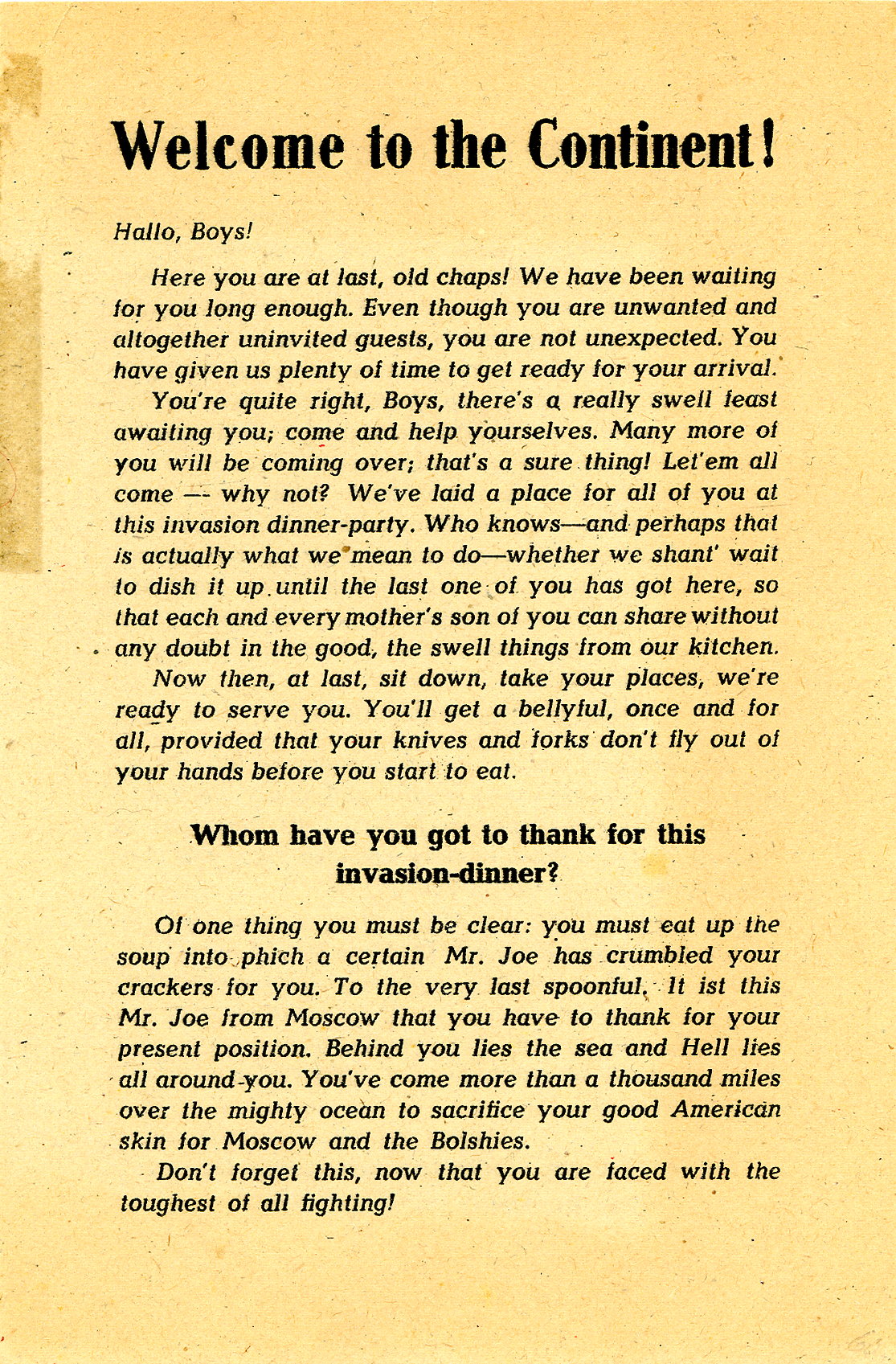
Welcome to the Continent!
The first leaflet is uncoded, all-text and says in part:
Welcome to the Continent!
Hallo Boys!
Here you are at last, old chaps. Even though you are unwanted and altogether uninvited guests, you are not unexpected…It ist (sic) this Mr. Joe from Moscow that you have to thank for your present position.
The back of the leaflet is all-text and says in part:
What exactly do you want in Europe?
But this is now the second time you are about to mix yourselves up in European affairs at the instigation of Jewish hate instincts and lust for power, although it is none of your business…The American continent has never been threatened by Germany. The Bolshies are the sworn enemy of all culture; they are the destroyers of religion and family life. That’s a fact every American knows…Think of them when you are facing death. Die for Stalin and Israel?
You Have Been Trapped!
The second German leaflet warns the Allies that they are fighting for a cause that will ultimately destroy their own countries. Notice that the leaflet is coded E114 / 3.44. The “E” is believed to stand for “Englander.” The 3.44 indicates that the German prepared this leaflet as early as March. Apparently, it was stored awaiting the invasion and disseminated in June 1944. There are a whole series of such leaflets, and we will mention more below. Some of the text on the front of this leaflet is:
YOU HAVE BEEN TRAPPED!
You have landed on the Continent to face the armed might of Germany – but not for the benefit of Britain!...The Bolsheviks alone will profit from your sacrifices. You have been trapped into risking your life for but one purpose – The Bolshevization of Europe…
WHY SHOULD YOU FIGHT FOR STALIN?
The back of the leaflet is even more interesting from the point of the message, which mentions the invasion. Some of the text is:
INVASION – WHY?
Have you any idea of the purpose of the attempted invasion of Western Europe? One thing is certain – the Allied casualties are and will continue to be enormous, although the amount of territory captured will be small…If this plan succeeded, Bolshevism would triumph over Europe – and
TRIUMPH OVER BRITAIN AS WELL!
Other leaflets in this “E” series are:
E108: Why die for Stalin? Why die for the Jews?
E111: Bolshevism – What is it? / The leopard cannot change its spots.
E113: Why die for Stalin?
E115: Stalin or your wife?
E116: Smuts said.
E117: Who gains? / You do not / Europe does not / But the Bolshevists do!
E118: Why die for the Jews?
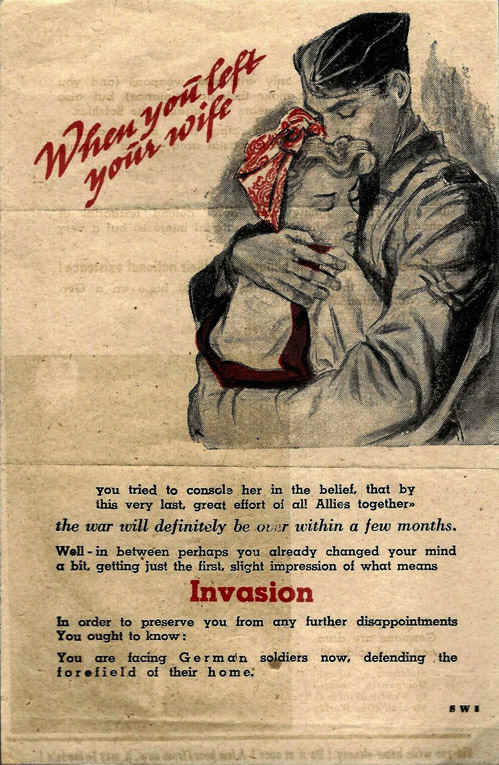
When you left your Wife
This leaded is coded SW5 and we know that the SW codes was used by the German Skorpion propaganda unit in Normandy against both Allied troops and French civilians. This leaflet seems aimed at the British because it depicts a British Corporal saying goodbye to his wife. The general theme of the propaganda on the front and back is that the Allies are no longer facing third-rate soldiers. They are now on the Continent and up against highly trained and well-armed German soldiers who will fight to the death to protect their wives and families. The leaflet ends with:
Did you write home already?Do it at once! A few hours from now, it may be too late!
Why die for Stalin? Why die for the Jews?
With the single exception of E108, all of the leaflets the Germans prepared in advance of the invasion are text only. I have added this leaflet because it is the only one that has an image on the front. The image depicts John Avery sitting in front of a typewriter. Your first impression is that this must be a well-known and trusted writer or broadcaster. In fact, he was a British Fascist who proposed to the Wehrmacht the formation of a British volunteer force (the British Free Corps) and made recruitment efforts and propaganda broadcasts for Nazi Germany.
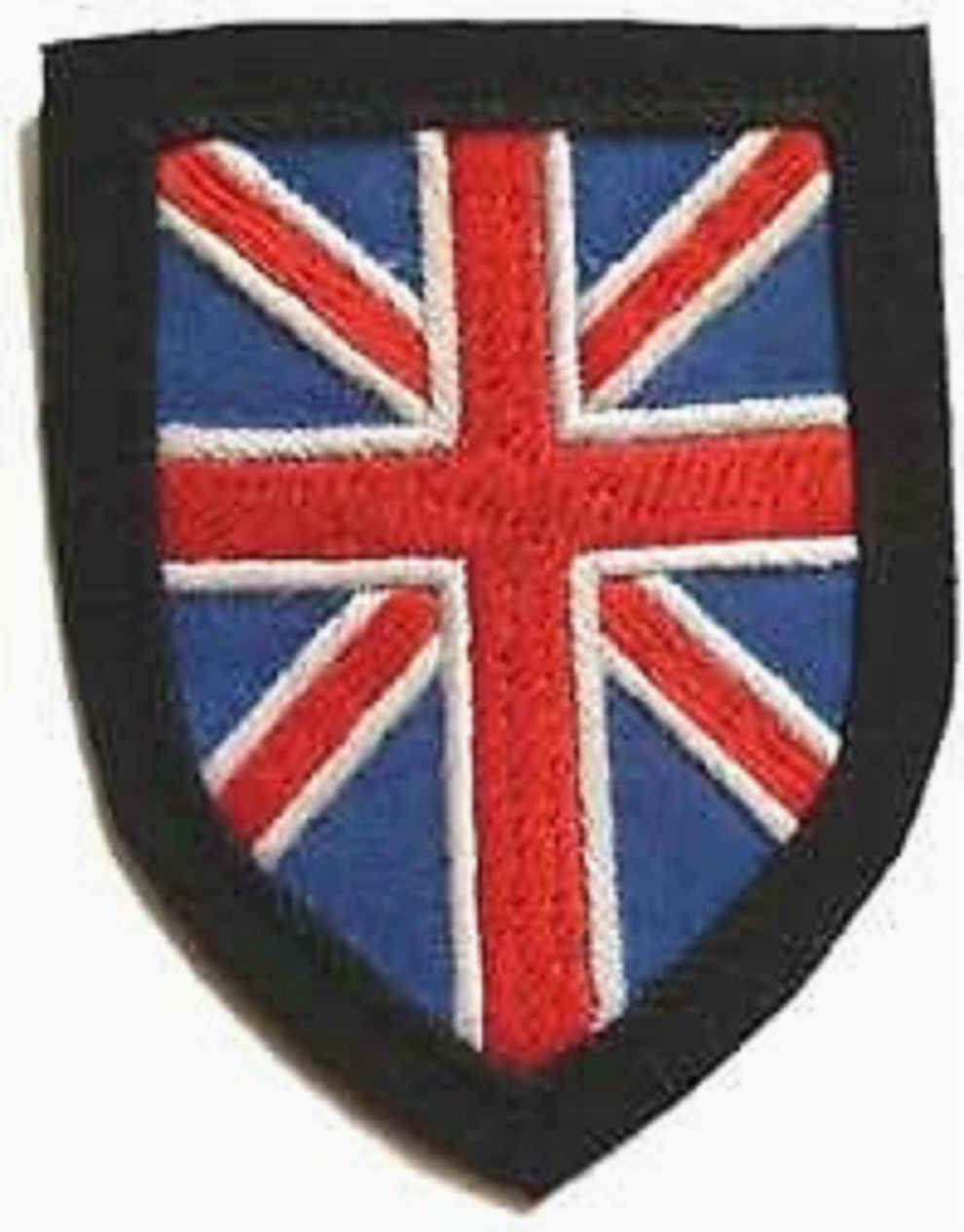
British Free Corps patch and sleeve insignia
Adolf Hitler was impressed by Amery and allowed him to remain in Germany as a guest of the Reich. During WWII the Germans authorized a number of foreign “Legions” made up of Croatian, Belgian, Estonian, Latvian anti-Communists among others. Somewhere between 300,000 and 500,000 men joined these anti-communist legions. The British were not quick to join the Nazis and research has found less than 60 men who admit to being a member at one time or another. At no time did it reach more than 27 men in strength, a bit smaller than a German Army platoon.
Amery made a series of pro-German propaganda radio broadcasts, attempting to appeal to Britons to join the war on communism. After the war he was put on trial and on the first day, 28 November 1945, Amery pleaded guilty to eight charges of treason. He was immediately sentenced to death. The entire proceedings lasted just eight minutes.
The text on this leaflet once again blames the Communists and the Jews for WWII, conveniently ignoring the fact that Hitler started the war by invading Poland, declared war of the United States for no reason, and attacked their ally, the USSR, without warning.

CAUGHT LIKE FOXES IN A TRAP
The third German leaflet is all-text with a divide and conquer message by the Germans trying to convince the Allied that they are fighting for the Soviet Union. The leaflet asks why the Germans have held back their secret weapons. Of course, the American soldiers did not know that the Germans were fooled by Allied deception, that the Germans believed that Calais was the actual invasion target, and that Hitler would not release his panzers wanting to save them for the real attack at the Pas de Calais, the closest area of France to Britain. Some of the text is:
CAUGHT LIKE FOXES IN A TRAP
Why has Jerry waited ten days after the landings to use his so-called secret weapon behind your back? Doesn’t that strike you as queer? It looks very much like after waiting for you to cross the Channel; he had set a TRAP for you…Meanwhile the robot planes, flying low, scatter over London and Southern England explosives, the power and incendiary efficiency of which are without precedent….
The back of the leaflet quotes stories from six newspapers. For instance:
Daily Telegraph – An incredible stream of German pilotless bombers is dropping a rain of high explosives over southern England. There is widespread destruction in many places….
The Second Invasion…
This German leaflet uses an interesting argument. It implies that when the British first went to the Continent to help France fight the Germans that was an invasion. Of course, it was not. It then says that this second invasion, in reality the first real invasion, is also doomed for failure and great loss of life. This leaflet is coded Kr-013-d-44. It is one of a series that uses various arguments, mostly the economic destruction of the Empire, to convince the British that the war has been lost already or will lead them to ruin. It also reminds the British that Rommel who so often beat them in North Africa is in charge of the defense of France. It casually mentions German bombers and the V weapons without actually naming them, and even brags that like Napoleon, Hitler was a corporal. It is a bit worn after about 75 years, but the propaganda argument is still interesting.
D-Day means Death-Day
I added this German leaflet at the last moment because it doesn’t quite make sense. First of all, it was dropped in Italy not in Western Europe, and secondly, D-day was 6 June 1944 and this leaflet is dated March 1945. Why wait eight months to drop a D-day leaflet? The back of the leaflet depicts a calendar of 1944 and 1945 with a red question mark and the text:
D-Day in Italy too?
I assume that the Germans are saying to the Allies that thousands died during the Invasion of Europe and once again thousands will die in Italy. The leaflet was designed and disseminated by the SS organization “Kurt Eggers,” section Sudstern (Southeast), for British and American troops in Italy in March 1945. After the attempt on Hitler’s life by the Army Generals, the fuhrer gave the propaganda operation to the SS and his trusted Heinrich Himmler.
German proclamation to the Occupied Channel Islands
Proclamation…
This interesting German proclamation to the occupied Channel Island of Jersey is dated 6 June 1944 and sent by Colonel Heine. The Commander of “Fortress Jersey” worries that his subjects will get overly excited. He tells that that if that happens he will take hostages and if necessary, execute them.
Clearing the Skies of German Aircraft
Where is the Luftwaffe?
This is one of several Allied leaflets used in Operation Pointblank to get the German Luftwaffe to come up and fight. 8,768,000 copies of this leaflet coded USG 31 were dropped in March and April 1944, just two months before D-Day. The text is:
The fateful question:
WHERE IS THE LUFTWAFFE?
That is the question that your soldiers have repeatedly asked on the Eastern Front and in Italy. “The Air Force defends the homeland,” they told them.
NOW IN THE LIGHT OF DAY American bombers fly in masse over Berlin. Today they were over the imperial capital city five times. Of course, you're asking too: Where is the Luftwaffe?
ASK GOERING! ASK HITLER!
Although I can make a case that Operation Pointblank was not really part of D-Day, there is no doubt that this plan to embarrass the German Air Force to take the skies to defend Germany was part of a psychological plan to force the Luftwaffe to take to the air where it could be shot down by Allied aircraft. The Allies already dominated the air but suspected there were hundreds of German aircraft being held back to defend against the invasion. This plan was designed to get them up in the air so that there would be no German air cover on D-Day.
Jeffrey O’Connor Whyte says in his PhD dissertation LINES OF COMMUNICATION: AMERICAN PSYCHOLOGICAL WARFARE IN THE TWENTIETH CENTURY, University of British Colombia, 2019:
By the spring of 1944, however, the Luftwaffe often declined to fly intercept sorties, electing to conserve fighters instead of sending them to likely destruction. The “problem” of the Luftwaffe’s unwillingness to fly fighters became as a result a new object of OWI psychological warfare. The question of “where is the Luftwaffe” had already been asked by American psychological warriors in leaflets dropped on German troops during the Italian campaign. Indeed, the very fact of leaflet drops communicated to enemy soldiers with special clarity their vulnerability to air attacks and the sardonic question of “where is the Luftwaffe” was meant to “play on resentments and anxieties” of Italian and German soldiers for whom no air support was available. Under Wallace Carroll’s direction in the spring of 1944, the OWI reprised the theme, and both leaflet drops and radio broadcasts to Germany conveyed the Allies’ mock surprise that the Luftwaffe would “allow” Allied bombing raids to advance deep into German territory largely unopposed.
Allegedly, during the build up to D-Day German infantrymen looked to the skies and said:
If you can see silver aircraft, they are American. If you can see khaki planes, they are British, and if you can’t see any planes, then they’re German.
German Fighter Commander, General Adolf Galland allegedly said:
From the very first moment of the invasion, the Allies had absolute air supremacy. Therefore, the enemy, our own troops, and the population asked the obvious question, “Where is the Luftwaffe?”
D-Day News Lingers On
British D-Day Stamp
One would assume that after 75 years there was not much left to say about D-Day. The British found a way to bring it back into the news. The Royal Mail announced a special series of stamps showcasing the ‘Best of British' in December 2018. One design showed American troops knee-deep in water as they disembarked from a landing craft. The caption said:
D-Day: Allied soldiers and medics wade ashore.
They had 75 years to get that picture right, but somehow they used a photo of American troops hitting the beaches in Dutch New Guinea. The landing craft was also incorrect.
Addendum
President Roosevelt’s D-Day Prayer
I am not a believer in coincidence so when just a day or two after I finished this article I read that a bill had passed regarding a D-Day prayer by the President of the United States I assumed that it was an act of providence. I have to add it or risk karmic retribution.
On 23 June 2014, by a vote of 370 to 12, the House overwhelmingly passed a D-Day prayer bill, and it is now headed to the President for signature. The legislation passed the Senate on 5 June 2014. The bipartisan bill directs the Secretary of the Interior to install a plaque or inscription at the National World War II Memorial in Washington, D.C. honoring the words that President Franklin D. Roosevelt prayed with the nation on 6 June 1944. Note that like Eisenhower, Roosevelt was not sure that the invasion would be successful. I will just quote the first few paragraphs of the prayer:
Almighty God: Our sons, pride of our nation, this day have set upon a mighty endeavor, a struggle to preserve our Republic, our religion, and our civilization, and to set free a suffering humanity. Lead them straight and true; give strength to their arms, stoutness to their hearts, steadfastness in their faith.
They will need Thy blessings. Their road will be long and hard. For the enemy is strong. He may hurl back our forces. Success may not come with rushing speed, but we shall return again and again; and we know that by Thy grace, and by the righteousness of our cause, our sons will triumph. They will be sore tried, by night and by day, without rest — until the victory is won. The darkness will be rent by noise and flame. Men's souls will be shaken with the violences of war….
This is just a short look at D-Day propaganda from both sides. As I write this, D-Day 2014 has just passed and I thought it might be nice to commemorate it with a short article. Readers that would care to comment are encouraged to write to the author at sgmbert@hotmail.com.
from Hacker News https://ift.tt/oe5UELQ


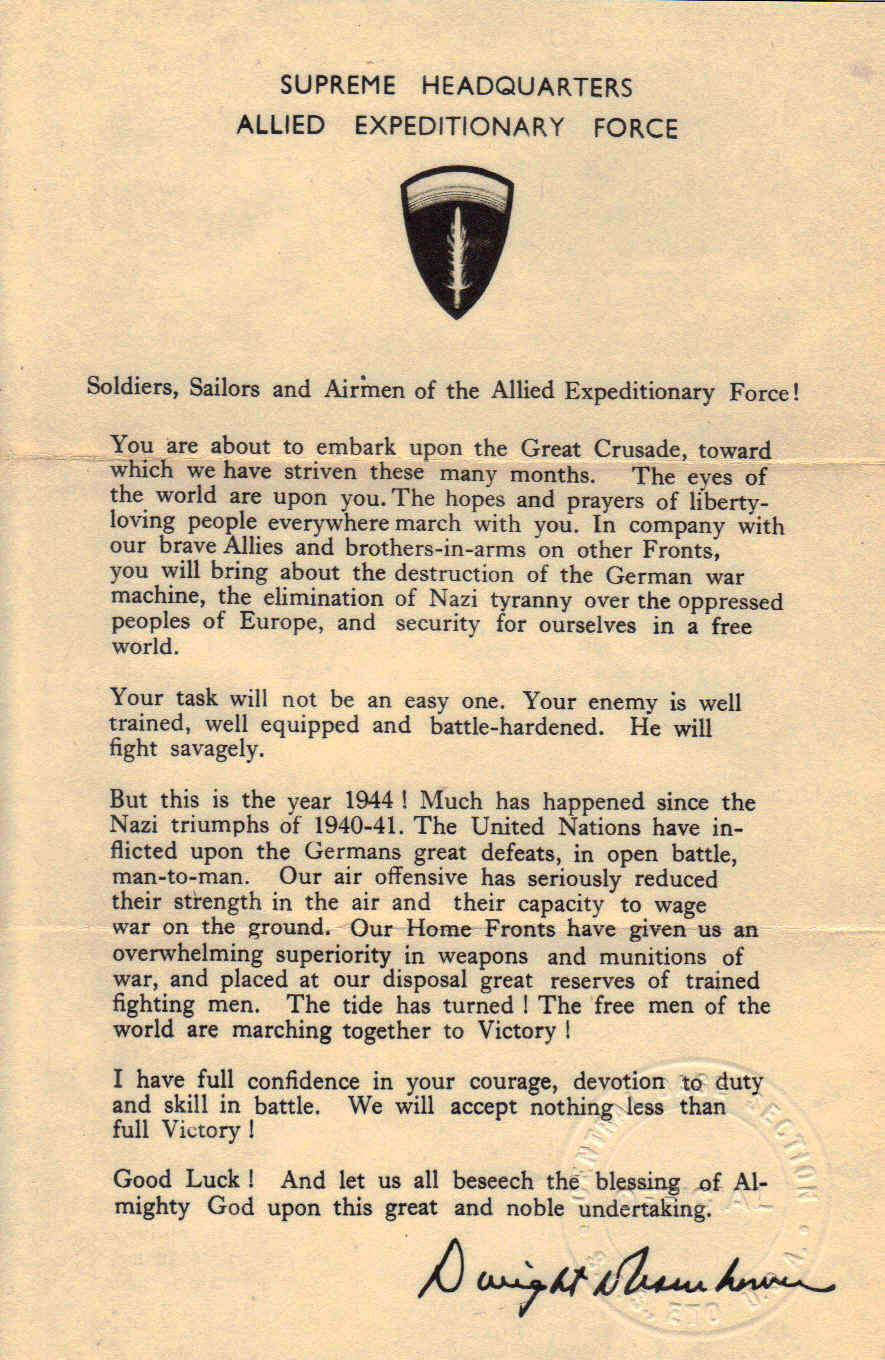
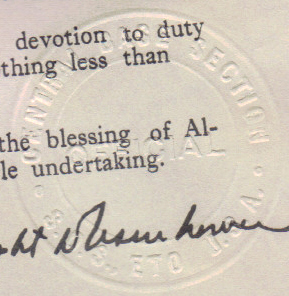







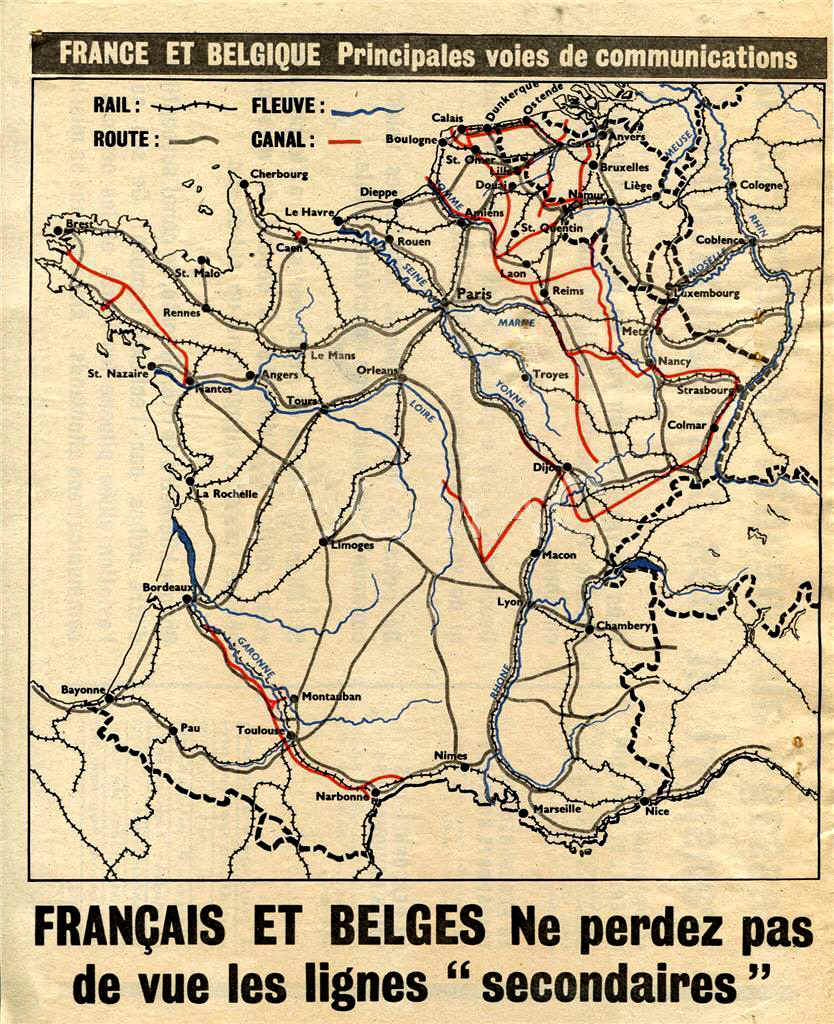



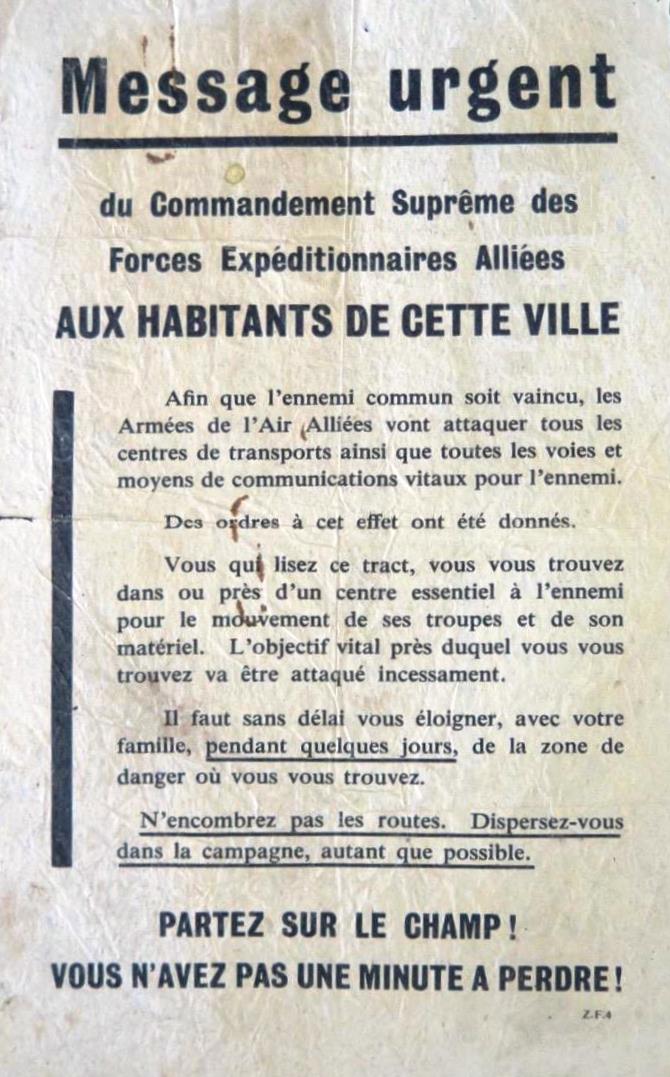




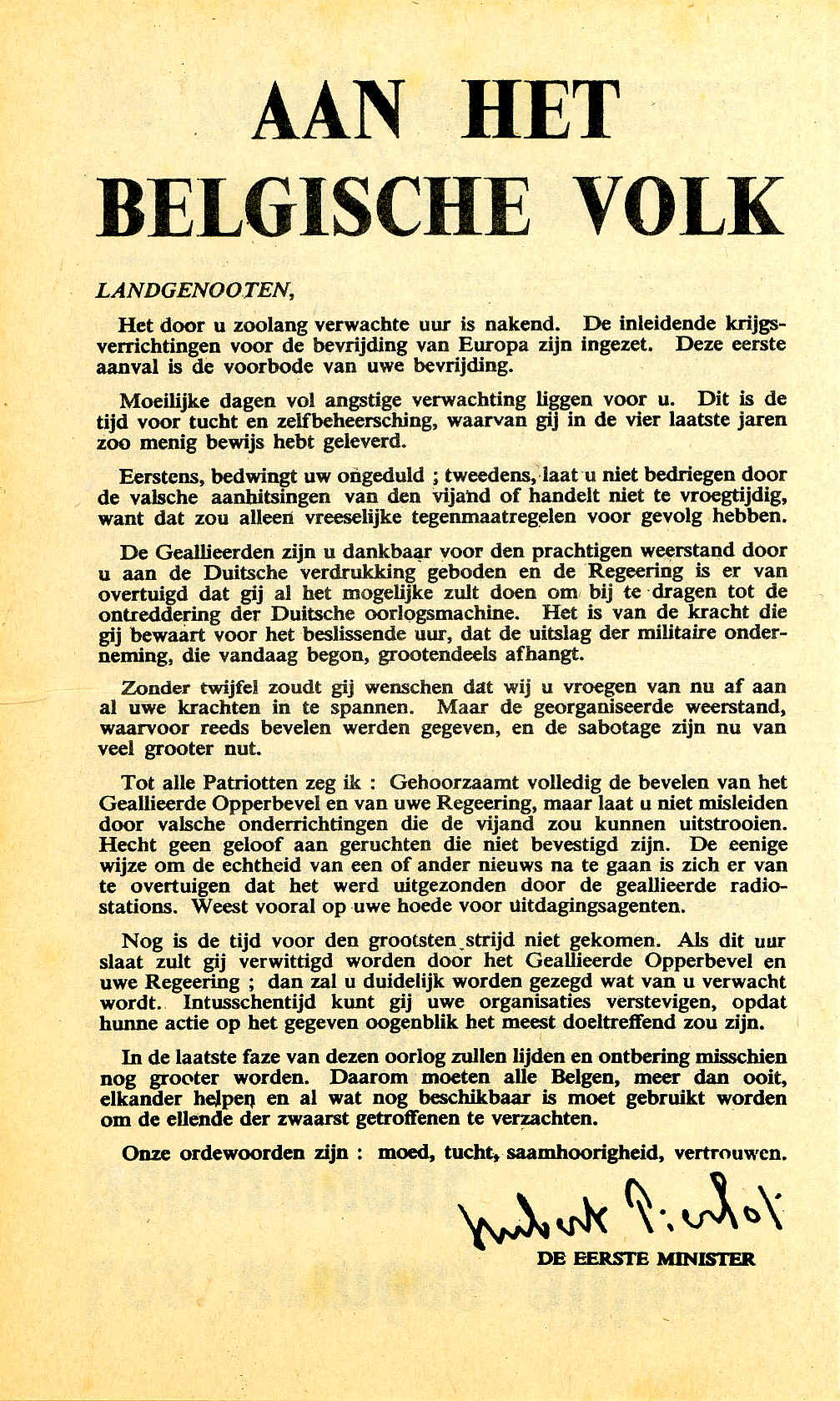

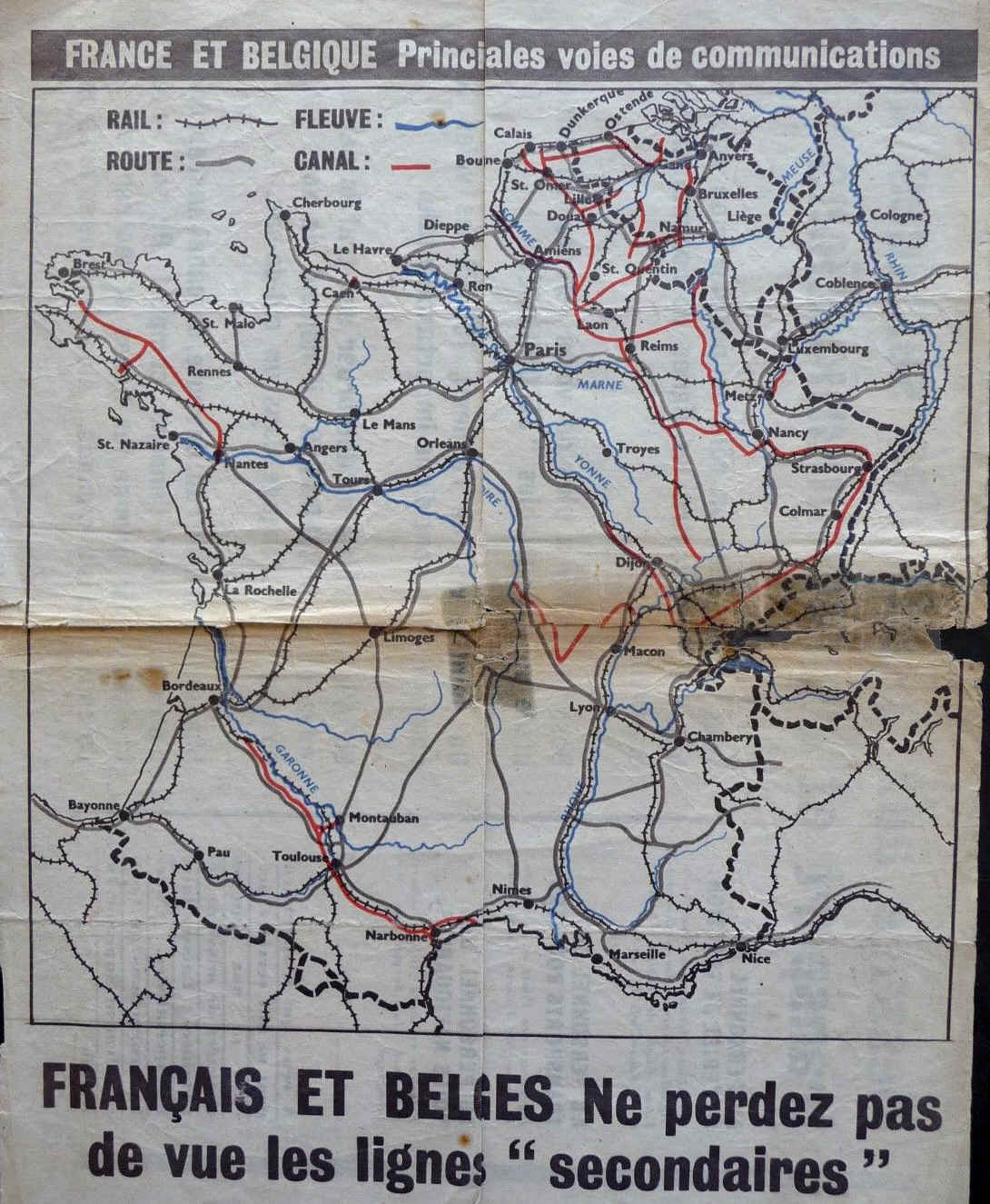
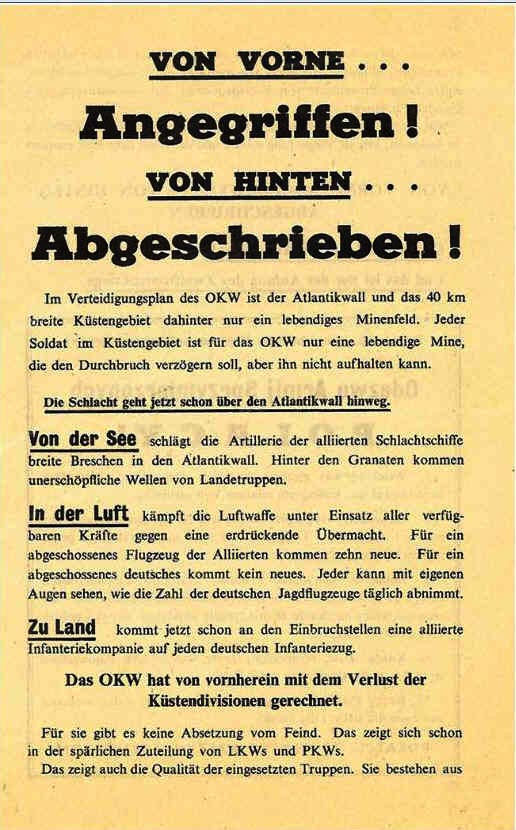
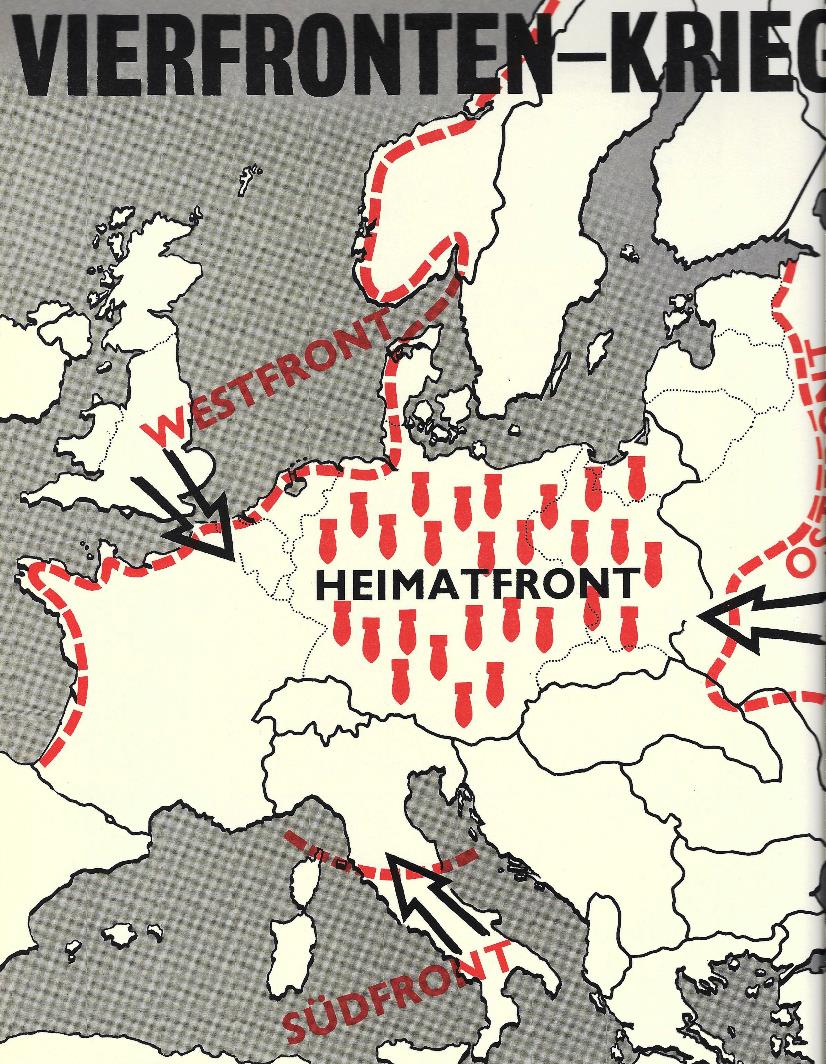
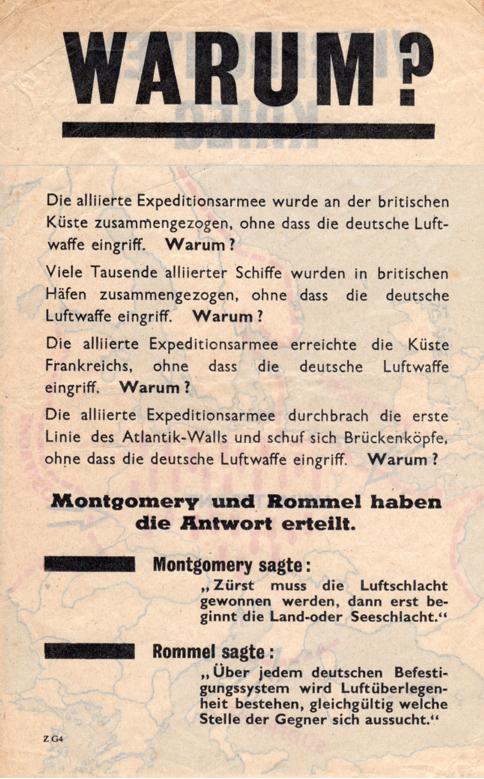







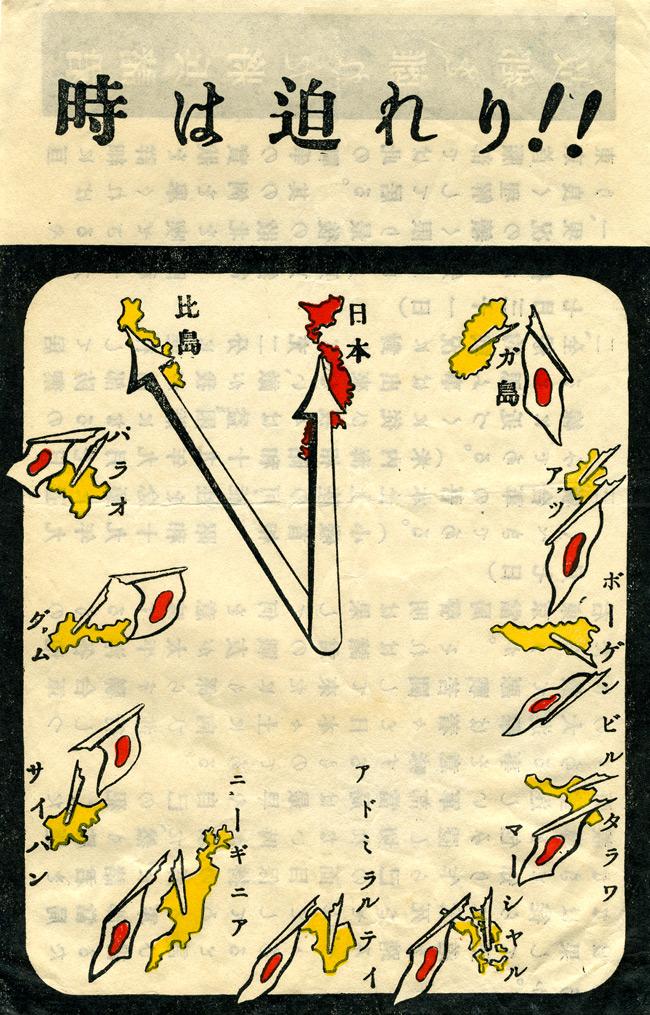




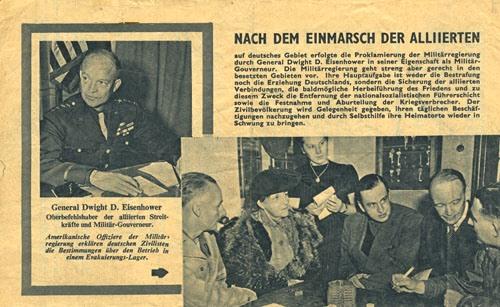


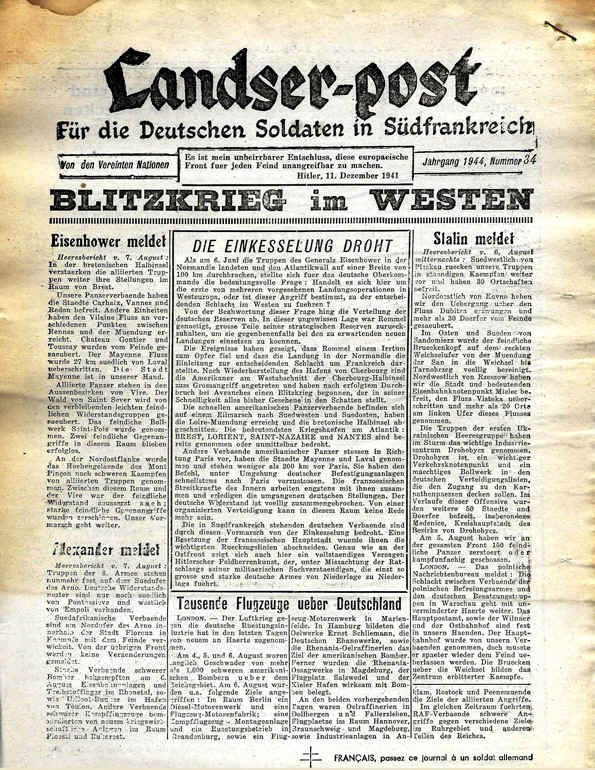


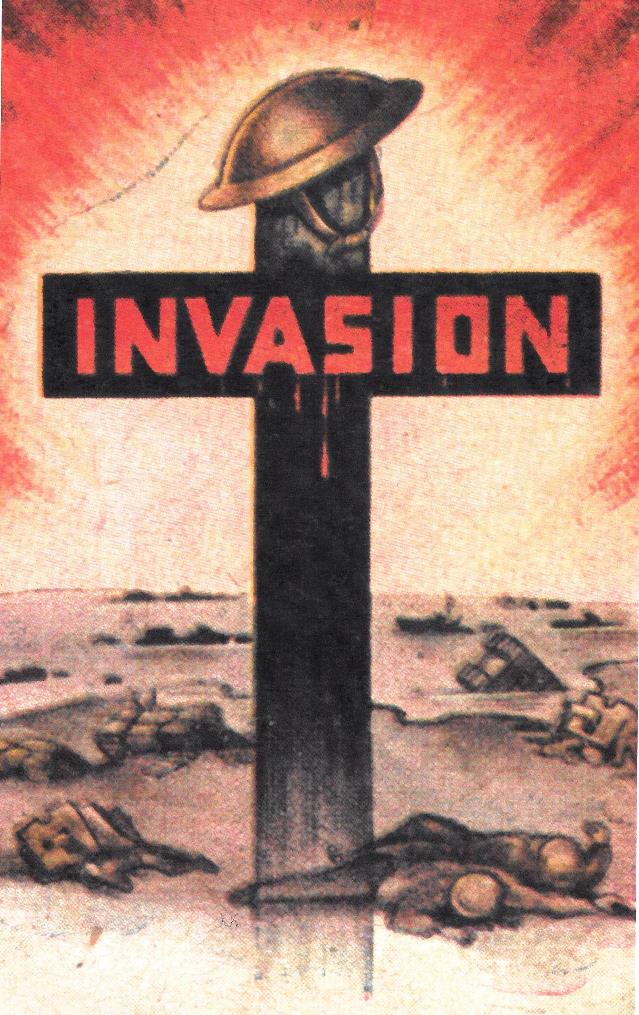
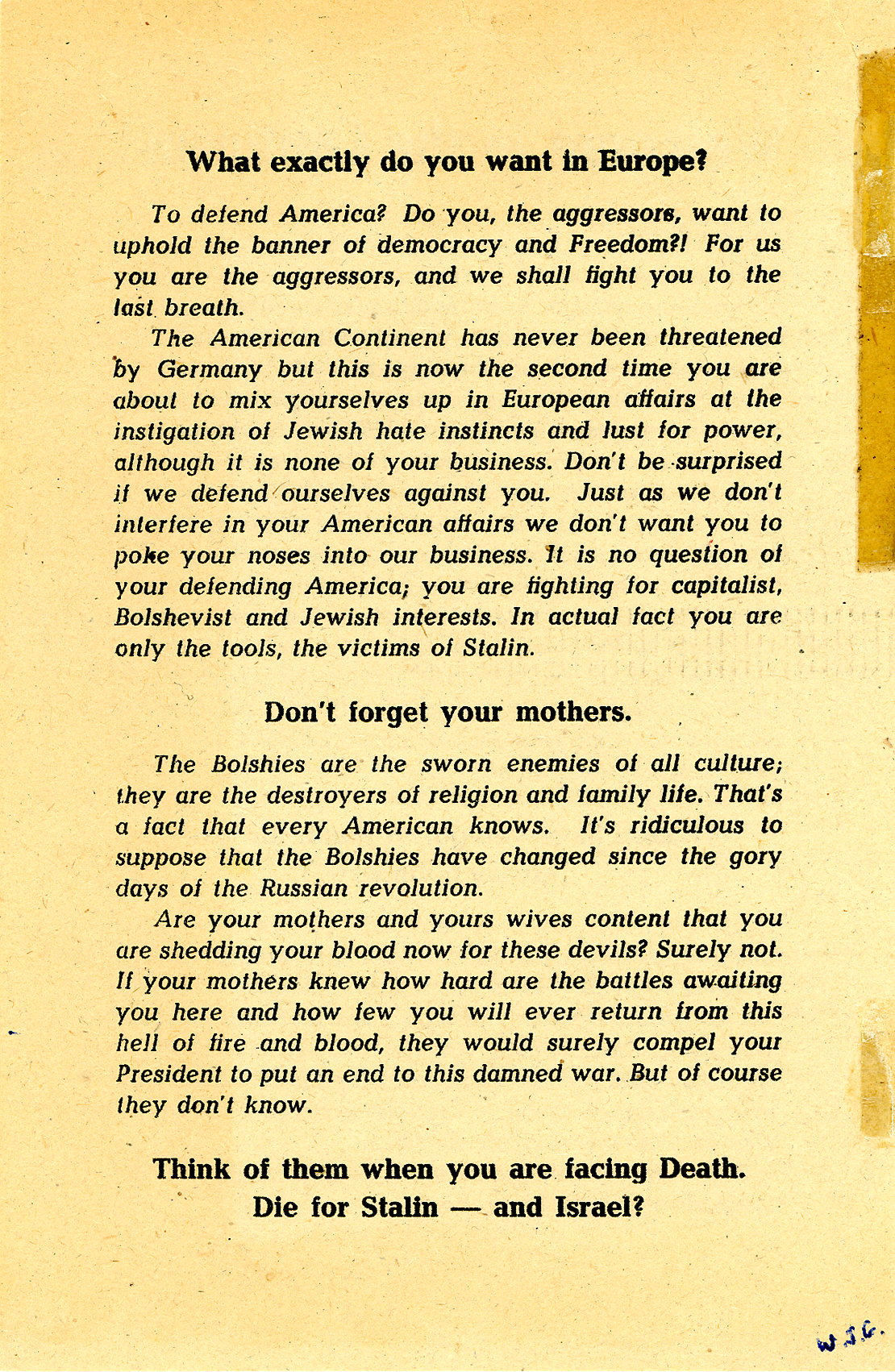
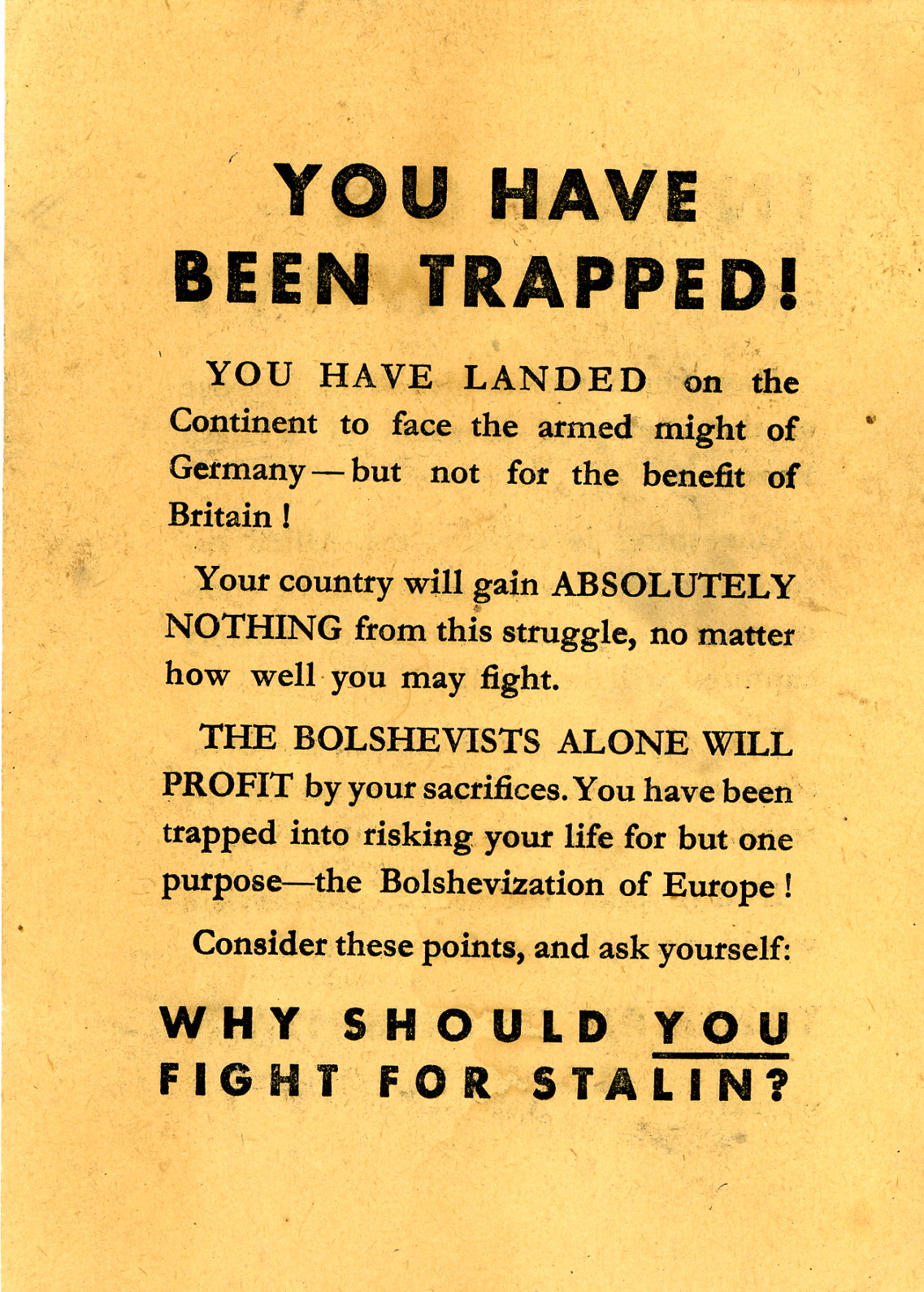


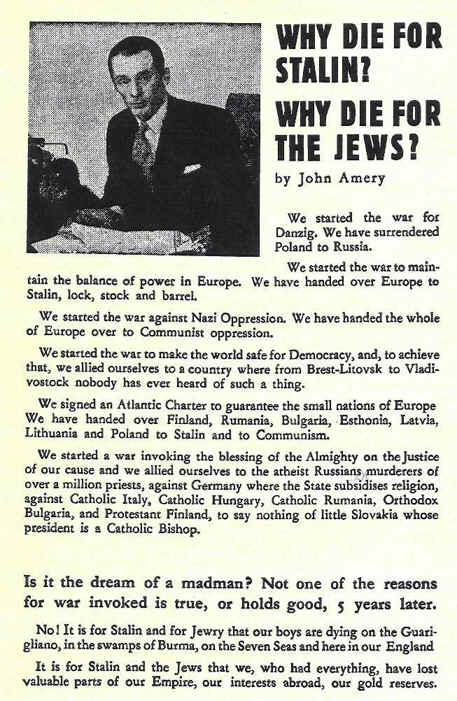
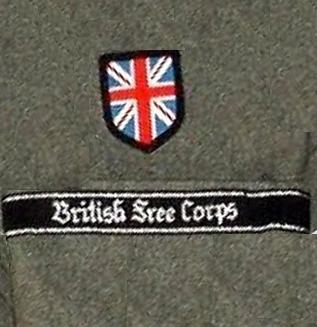
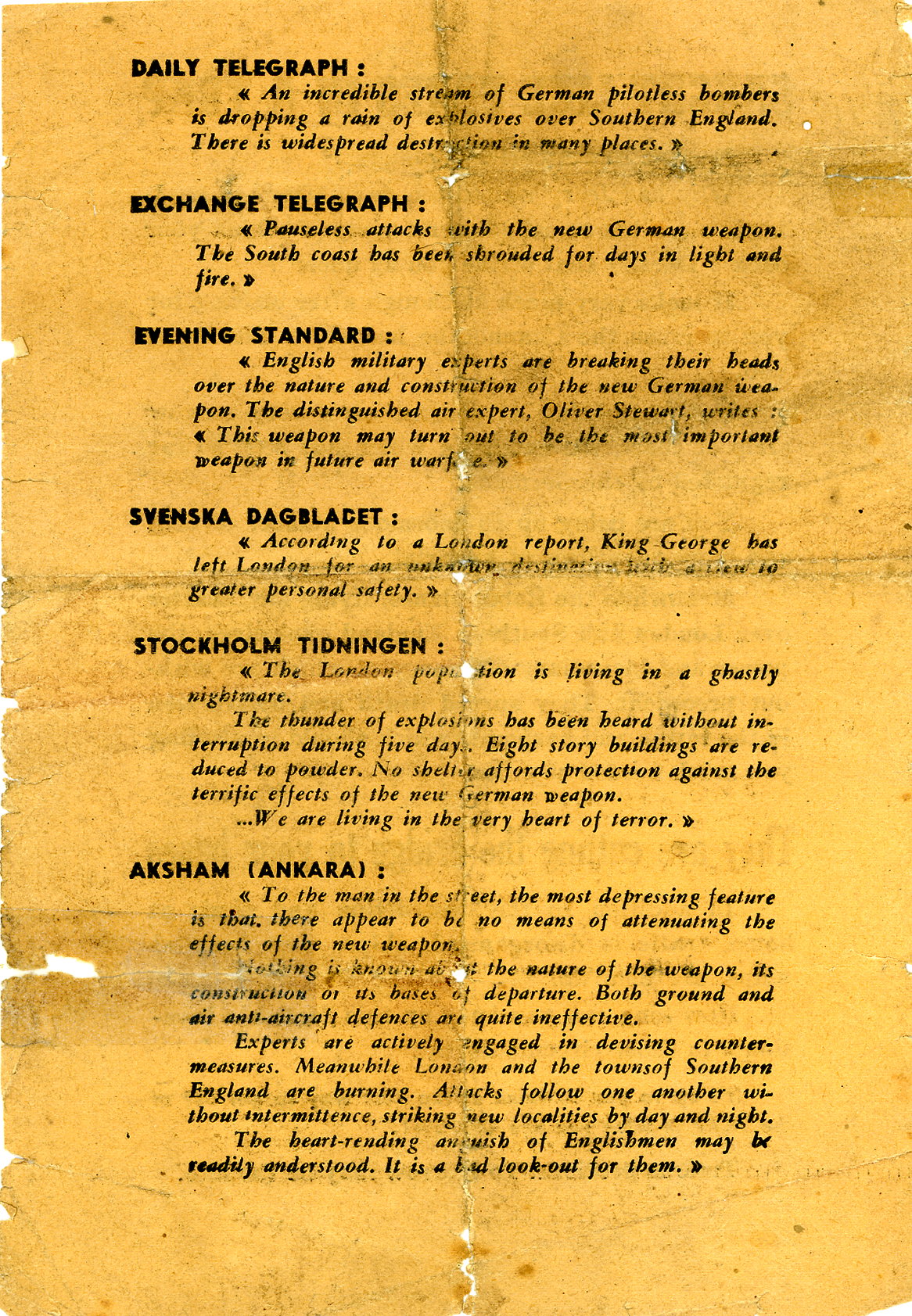
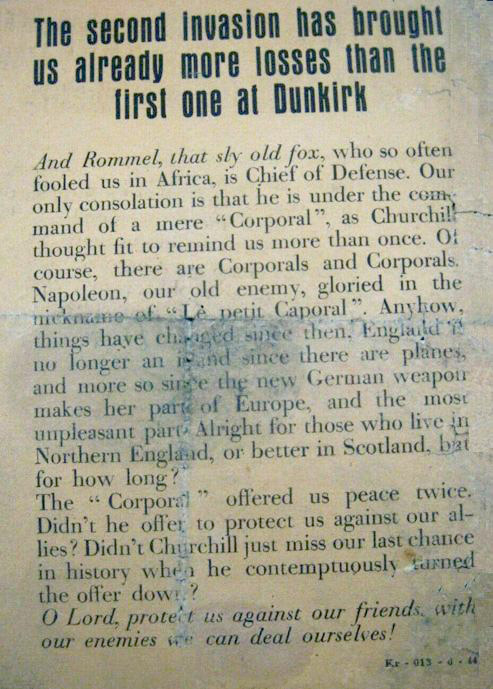





No comments:
Post a Comment
Note: Only a member of this blog may post a comment.